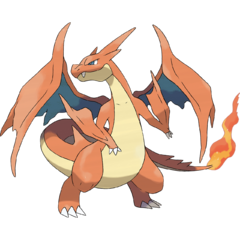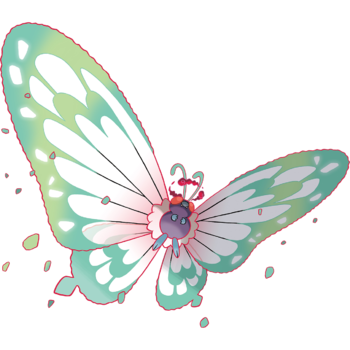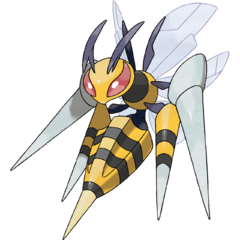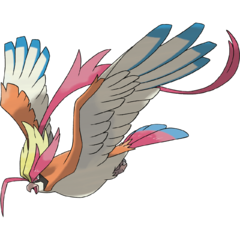0001: Bulbasaur / Fushigidane (フシギダネ fushigidane)
0002: Ivysaur / Fushigisou (フシギソウ fushigisou)
0003: Venusaur / Fushigibana (フシギバナ fushigibana)
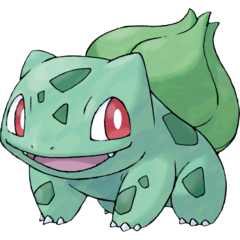

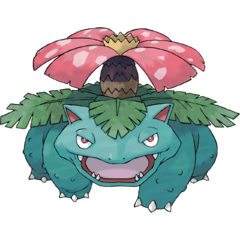
A teal, toad-like creature which has a bulb planted on its back, its evolution consists of bodily growth similar to an armored dinosaur, and the bulb flowering and eventually turning into a large plant. This family is the first in many aspects: The first Pokémon in the National Pokédex order, the first Grass-type, Poison-type and Dual-typed ones too, and, as a starter in the Kanto-based games, the first Pokémon of roughly one third of the first Pokémon players. Bulbasaur is considered the strongest choice as it makes the first two gyms a cake walk and has resistances against all of the remaining gyms sans Sabrina and Blaine (though by the time you get to them you're most likely to have a more diverse team with members that have advantages over them anyway). It also has advantages against two of the four Elite Four members: It resists Bruno’s fighting types and is super effective against his Rock/Ground type Onixes, and since almost all of Lorelei’s Pokémon are water type (and slower than Venusaur) it has a strong advantage there too. In addition, its access to Sleep Powder gives it the ability to take almost anything out of play for a few turns. In battle, it can utilize both strong utility in its status effect as well as high damage. It is quite well-rounded and can be used offensively or defensively quite easily.
Venusaur gained a Mega Evolution in X and Y. Mega Venusaur's offenses and defenses receive a boost and even an ability which cuts damage from its fire and ice weaknesses in half. A special Venusaur introduced in Sword and Shield's "Isle of Armor" DLC is capable of Gigantamaxing, its flower growing so large that it covers its whole body and helps defend against attack, and generating enough pollen to cause unprepared people to faint, while growing large plants in its wake. Overall, Venusaur has had some of the most consistent competitive viability of any starter Pokemon.
Ivysaur appears alongside Squirtle and Charizard as a trio of fighters under the Pokémon Trainer fighter's command in Super Smash Bros. Brawl, the 3rd entry of Nintendo's Massive Multiplayer Crossover Fighting Game series, and then after being absent for a game, returned in Super Smash Bros. Ultimate, the latest entry, alongside Squirtle, reuniting with Charizard. For tropes concerning its Smash incarnation, see the Super Smash Bros. Brawl character page.
- A.I. Breaker: Thanks to its Poison typing the Bulbasaur line can exploit this heavily. Gen I's Trainer AI is programmed to always use moves that are of a super effective type, even if the move does no damage. Many Pokémon learn non-damaging Psychic type moves (Agility, Barrier, Light Screen, Reflect, etc.) which they will infinitely spam against Bulbasaur and its evolutions, resulting in easy damageless fights.
- Acrofatic:
- Thanks to its Chlorophyll hidden ability that it obtained in Generation V, Venusaur's speed doubles as long as the Sun weather effect is active. This turns Venusaur from a Mighty Glacier into a Lightning Bruiser.
- In order to get Venusaur's 3-star picture in New Pokémon Snap, you must make it hop away, which it does surprisingly fast for a Pokémon of its size.
- Alluring Flowers: Many Pokédex entries for Venusaur note that its flower attracts other Pokémon, with one entry describing it as "bewitching".
- Armor-Piercing Attack: Razor Leaf, thanks to its nigh perfect ability to critical hit, piercing defensive buffs.
- Attack of the 50-Foot Whatever: Venusaur's Gigantamax form is nearly 80 feet tall.
- Balance Buff: The line was given Chlorophyll as a Hidden Ability in Gen V, which helped greatly improve its ability to sweep.
- Barrier Warrior: Can learn Light Screen to boost its impressive Special Defense even further.
- Bullet Seed: The line can use seeds as weapons in several ways, such as the moves Seed Bomb, Worry Seed, and…well, Bullet Seed.
- Cartoon Creature: Are they toads? Lizards? Dinosaurs? Dicynodonts?
 Bulbasaur's Japanese name even translates into "isn't it strange". In-universe, there is a mystery on whether to classify it as a plant or an animal. Pokémon Let's Go, Pikachu! and Let's Go, Eevee! shows Venusaur hopping like a toad when following behind the player, muddying the waters further. Sugimori confirmed in an interview that they are meant to be “toad-like”, but comparing them to the myriad Pokémon more directly based on frogs and toads makes it clear that Bulbasaur and its ilk are Cartoon Creature "toad monsters" the same way Lugia is a "bird monster" rather than an actual bird.
Bulbasaur's Japanese name even translates into "isn't it strange". In-universe, there is a mystery on whether to classify it as a plant or an animal. Pokémon Let's Go, Pikachu! and Let's Go, Eevee! shows Venusaur hopping like a toad when following behind the player, muddying the waters further. Sugimori confirmed in an interview that they are meant to be “toad-like”, but comparing them to the myriad Pokémon more directly based on frogs and toads makes it clear that Bulbasaur and its ilk are Cartoon Creature "toad monsters" the same way Lugia is a "bird monster" rather than an actual bird. - Cold-Blooded Whatever: Their design incorporates aspects of dinosaurs, reptiles and frogs, with a dash of prehistoric dicynodonts in there as well.
- Critical Hit: One of the things that made the Bulbasaur line so overpowered in generation 1: Razor Leaf was essentially a guaranteed critical hit thanks to the mechanics for crits in that generation. This made it a 110 power, 95 accuracy attack that ignored enemy defense buffs. And Ivysaur learned this at level 30. For comparison, at that level the strongest attack Charmeleon has is Ember, at 40 power, and Wartortle has Bubblebeam through TMs, at 65 power. They don’t naturally learn another same type attack for quite a while either; the next same type attack Charizard gets is Flamethrower (95 power, 100 accuracy attack) at level 46, and for Blastoise is Hydro Pump (120 power, 80 accuracy) at level 52. Both of these have a lower average damage output (factoring in accuracy) than Razor Leaf.
- Crutch Character: In the generation I games and their remakes, Bulbasaur is a downplayed example. Early in the game, it has a very easy time, owing to learning the powerful Razor Leaf early on, being strong against Brock and Misty’s gyms while resisting Lt. Surge’s, and coming with some useful status moves like Leech Seed and the status powders. These advantages continue through most of the game, though Blaine and Sabrina require more team support to work around.
- Disc-One Nuke: Bulbasaur crushed Red and Blue to a ridiculous degree thanks to its favorable match-ups against a large number of gyms. In order, it is: super effective against Brock and Misty, resistant to Surge and Erika, and then super effective against the last gym leader, with only Sabrina and Blaine standing much of a chance against it, but by that point, you should either have another Pokémon that can take them out or have leveled Venusaur up to such ridiculous levels that the type disadvantage doesn't matter.
- Elemental Rock-Paper-Scissors: Subverted to its great benefit in its generation. In generation 1 the Bulbasaur line was weak to fire, ice, flying, psychic, and bug. But there were virtually no good Bug attacks (save for Pin Missile, which exactly 2 Pokémon could learn, but both were unavailable in the wild and extremely rare among enemy trainers), almost every ice type attack was on a water type Pokémon (which is weak to grass) and only appeared in the very late game, and fire types were so rare they didn’t present a meaningful issue until the second to last gym. For nearly the entire game only Flying and Psychic attacks were meaningful weaknesses.
- Energy Ball: They can learn the move called Energy Ball from Diamond and Pearl and on.
- Enchanted Forest: In the anime, some Bulbasaur go to evolve in a special forest.
- Floral Theme Naming: Fitting for a grass-type family. Notably, the first part of “Venusaur” doesn’t refer to the Roman goddess, but the Venus fly-trap.
- Green Thumb: Part Grass-types. Gigantamax Venusaur is of note for generating large amounts of pollen that stimulate plant growth.
- Healing Factor: Can learn Synthesis, which restores their HP depending on what kind of weather is present in battle.
- Inconsistent Coloring: Bulbasaur's body is supposed to be blueish-green according to its artwork. This has not stopped the Generation II games from giving Bulbasaur a body as green as its bulb, or the Generation VI games giving it a body that is much more green than blue.
- Kevlard: Its Mega Evolution gets Thick Fat as an ability, letting it withstand Fire-, and Ice-type attacks.
- Kaiju: Gigantamax Venusaur is a massive towering beast draped in a gigantic flower. It’s described as possessing the strength to topple skyscrapers.
- Kryptonite-Proof Suit: Upon Mega Evolving, Mega Venusaur gains the ability Thick Fat, which halves the power of Fire and Ice-type attacks, removing two of its weaknesses.
- Improbable Aiming Skills: Since Venusaur is a Poison-type, Toxic will hit any target whether they are flying, digging, swimming, etc.
- Informed Flaw: Ivysaur's front sprite in Red and Blue depicts it standing on its hind legs, even though several Pokédex entries (including that of those very games) state that it cannot do so. Later sprites and models correctly reflect those Dex entries, though.
- Land, Sea, Sky: Venusaur is the Land to Blastoise's Sea and Charizard's Sky.
- Life Drain: Naturally learns Leech Seed, and can get Giga Drain through breeding.
- Lightning Bruiser: Venusaur has the potential to be one if it has the Chlorophyll ability, which doubles its speed in the sun, as it has fairly strong offensive and defensive stats to begin with.
- Loophole Abuse: In Generation VI, a Chlorophyll Venusaur in the Sun will still have double speed the turn it Mega Evolves due to turn order being determined before the round plays out. Removed in Gen VII, which now determines turn order after the Mega Evolution occurs.
- Magic Knight: Venusaur has a usable Attack stat and a good Special Attack stat.
- Man-Eating Plant: Downplayed, as Venusaur isn’t described as particularly aggressive to humans, but the name references a carnivorous plant, and the more dinosaur-related features conjure a sense of danger.
- Meaningful Name:
- The three names add "saur" to the words bulb (referencing plant bulbs
 ), ivy
), ivy , and Venus (most likely referencing a Venus flytrap
, and Venus (most likely referencing a Venus flytrap ).
). - "Fushigi" (不思議) means "strange," "mysterious," or "wondrous." "Fushigi da ne" means "Isn't it strange?" However, "dane" here is likely an alternate reading of "tane" (種), meaning "seed
 ." "Sou" (草) means "grass
." "Sou" (草) means "grass ." Finally, "bana" is an alternate reading of "hana" (花), meaning "flower
." Finally, "bana" is an alternate reading of "hana" (花), meaning "flower ."
."
- The three names add "saur" to the words bulb (referencing plant bulbs
- Missing Secret: In Gold and Silver, the line has Charm listed as a possible Egg Move, but it's impossible to learn legitimately since its only eligible breeding partner with the move is female-only (Nidoran-F, who itself only gets it as an egg move). This was fixed in the Generation III games, where it can learn it from the Shroomish family.
- Mighty Glacier: With a bulky 100 on both Special stats with everything else in the 80s, it can deal a decent Special hit and take a strong one in kind, but is easily outsped. Its Mega Evolution emphasizes this by giving it Thick Fat, leaving only Flying and Psychic as its weaknesses and beefing up its defenses to 123/120 while Speed remains stuck at 80.note
- Mundane Utility: Since Bulbasaur and the rest of the family are quadrupeds, the vines that grow from the plant on its back are often used as an extra set of hands or as ropes in the anime.
- No-Sell: Is immune to poison status entirely thanks to its poison typing. This was especially relevant to Bulbasaur’s very strong early game in Pokémon Red and Blue: Poison was a near-unavoidable early game hazard that was quickly lethal thanks to dealing damage outside of battle.
- Out of Focus: Downplayed. In earlier promotional material, Venusaur was often depicted as Red's Signature Mon, with the most notable example being in Pokémon Adventures. Eventually, Charizard, and then Pikachu, replaced Venusaur as Red's ace. Despite this, Venusaur still gets a good deal of publicity as one of the original starter Pokémon and has been one of the most consistently represented starters in competitive play.
- The Paralyzer: With Stun Spore, it's able to paralyze an opposing Pokémon. This gets highlighted in Gigantamax Venusaur's Pokédex entry.Huge amounts of pollen burst from it with the force of a volcanic eruption. Breathing in too much of the pollen can cause fainting.
- Petal Power: Learns Petal Dance and Petal Blizzard, both of which use flower petals to attack opponents.
- Planimal: Moreso than anything else released in Red and Blue, as other Grass Pokémon that existed at the time tend to be anthropomorphic plants with faces and sometimes limbs.
- Poisonous Person: It has never had a large number of Poison moves to choose from, though. Bulbasaur was unique in that it was the only basic-stage starter from the main games with dual types until the introduction of Rowlet in Sun and Moon.
- The Power of the Sun: Venusaur has three moves and one ability that all benefit from sun weather effect being active:
- Its hidden ability, Chlorophyll, will double its speed.
- Solar Beam, which typically takes one turn to charge and the second to attack, can be used in a single turn.
- Growth will power up Venusaur’s Attack and Special Attack by two stages instead of one.
- Weather Ball will turn into a fire-type attack, giving Venusaur some needed extra coverage.
- Prehistoric Monster: While the nomenclature of the line indicates that they're based on dinosaurs or other prehistoric reptiles, they closely resemble the Beelzebufo, a monstrous species of prehistoric frog. Such a resemblance would be coincidental at best though, considering Beelzebufo was described well after the Bulbasaur line debuted.
- Pun: So Venusaur is a frog-like Pokémon who has a tree on its back, A tree frog.
- Red Eyes, Take Warning: A more disturbingly realistic example than most. In Pokémon Stadium, Venusaur's eyes turn bloodshot red when attacking.
- Ridiculously Cute Critter: Bulbasaur is pudgy and adorable, in contrast to its more monstrous evolutions.
- Secondary Sexual Characteristics: Female Venusaur have a seed growing atop their flower.
- Secret Art:
- Frenzy Plant was exclusive to Venusaur before XD, and nowadays it is the Secret Art of the fully-evolved Grass starters. Grass Pledge, too, as it is a Grass Starter.
- Gigantamax Venusaur is the only Pokémon that can use G-Max Vine Lash, a move that damages all non-Grass types for four turns.
- Signature Move: Each of its stages are associated with the phase of the seed on its back. Bulbasaur with Leech Seed, Ivysaur with Razor Leaf, and Venusaur with Solar Beam. The line as a whole is most associated with Solar Beam, and Vine Whip which it uses as arms.
- Starter Mon: One of the starter Pokémon of Kanto. Bulbasaur is Gen I's strongest since it fares particularly well in the early and mid game. It can also be obtained early in Pokémon X and Y. Can also be considered the trope namer, given its position as the first entry in the Pokédex.
- Status Buff:
- They can learn Growth naturally. Normally, it would raise its Attack and Special Attack stat. In harsh sunlight, Growth sharply raises its Attack and Special Attack instead.
- Bulbasaur can have Amnesia as an egg move, which sharply raises its Special Defense stat.
- The line can have Chlorophyll as their hidden ability. It doubles their speed during harsh sunlight.
- Status Effects: The line can learn a few status-effecting moves such as Sleep Powder and Poison Powder.
- Status Effect-Powered Ability: A uniquely powerful example in Leech Seed and Toxic: In generation 1, if Leech Seed was used on an opponent afflicted with Toxic, the health drain would also scale with the Toxic effect. So using Toxic first made Leech Seed exponentially more powerful, to the point of getting a KO and restoring all of your health after just a few turns.
- Super Mode:
- Gen VI gave Venusaur a Mega Evolution. Mega Venusaur becomes even more of a Mighty Glacier, gaining boosted Defense, Special Attack, and Special Defense, in addition to gaining the Thick Fat Ability, negating its Grass-type weaknesses to Fire and Ice.
- Gen VIII DLC gives it a Gigantamax form, turning its Grass-type moves into G-Max Vine Lash, which inflicts passive damage on non-Grass-type Pokémon for several turns.
- Super-Strength: Venusaur can stomp hard enough to shake the ground. This extends to its vines, which have been shown to knock down trees, amongst other feats.
- Tactical Rock–Paper–Scissors: While this applies to Pokémon mechanics in general, Venusaur can make particularly good use of it with Weather Ball and various weather effects. Especially sun, which Venusaur can also get a significant speed boost from through Chlorophyll.
- There Is No Kill Like Overkill: While this applies to any grass-type move against the common ground/rock type combination, Razor Leaf is an especially notable example (hitting for 8x the base damage).
- Towering Flower: Venusaur sports a massive one on its back. Exaggerated when it Gigantamaxes, with the flower growing to a gargantuan size and enveloping its body.
- Turns Red: Overgrow boosts their Grass attacks when they're at 1/3 health or lower.
- Unblockable Attack: It learns Toxic, which as a Poison-type will always poison anything without immunities.
- Vine Swing: It rarely does this itself, but often allows other Pokémon to swing from its vines.
- Vine Tentacles: Its prehensile vines are both incredibly strong and flexible, often used like arms or long tentacles.
- Who's on First?: Bulbasaur's Japanese name can be translated to "isn't it strange?"
0004: Charmander / Hitokage (ヒトカゲ hitokage)
0005: Charmeleon / Lizardo (リザード rizaado)
0006: Charizard / Lizardon (リザードン rizaadon)
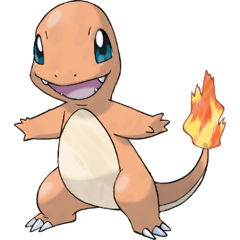

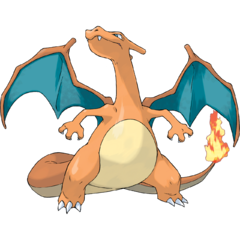
A bipedal, orange, lizard-like creature with a flame on the tip of its tail, it first evolves into a more feral version of itself with red coloring and a horn on the top of its head, then regains its original color at the next stage as it becomes a two-horned winged dragon. The first Fire-type and single type in National Dex order, as well as the first change of type upon evolution (gaining Flying as a secondary type as Charizard). It's the second starter for the Kanto region. An offensive-oriented fighter, it has some crippling weaknesses due to its typing, but it may be able to take down an opponent before they can exploit its weaknesses. Charmander is considered by many to be the hard mode of the game as it has no advantages against any of the gyms except Erika and four of the Gyms have big advantages against it. It gains two Mega Evolutions in X and Y, Mega Charizard X and Mega Charizard Y. The former focuses on Charizard's draconic aspects and gives it the Dragon-type along with a brand-new color scheme, higher Attack stat, and an ability that powers up its contact moves. The latter focuses more on its Flying-type aspects and gives it a more aerodynamic design, a higher Special Attack, and the Drought ability. In Alola, the family isn't native to the region,note but a Charizard Poké Ride is available for the player to fly to previously visited locations. In Sword and Shield, special Charizard can undergo a Gigantamax transformation in certain battles to turn into a 91+ foot-tall giant with even more firepower, flames hotter than 3600 degrees Fahrenheit, and an exclusive attack that deals tons of fire damage and engulfs the enemy in a vortex of flame for several turns.
Charizard appears as a playable fighter in Super Smash Bros., Nintendo's Massive Multiplayer Crossover Fighting Game series. In Super Smash Bros. Brawl, it was one of a trio of playable Pokémon under the Pokémon Trainer fighter's command. It then also became its own fighter in Super Smash Bros. for Nintendo 3DS and Wii U, before reuniting with Squirtle and Ivysaur in Super Smash Bros. Ultimate. For tropes concerning its Smash incarnation, please see the Super Smash Bros. Brawl character page.
- Achilles' Heel: Rock-type attacks for Charizard thanks to an unfortunate double weakness. This was always an issue, but became really prominent with the introduction of Stealth Rock, an entry hazard that was the single most central move in competitive play across multiple generations. Charizard took quadruple damage to it (losing half its health when switching in), making it near impossible to viably use without later generation Super Mode mechanics (like Gigantamax) or Heavy-Duty Boots.
- Acrofatic: In spite of its rather stout build, Charizard is decently fast, having a base Speed stat of 100note , and is consistently depicted as one of the best fliers in Pokémon media. In fact, Charizard has the same base Speed stats as its Mega Evolutions, which have a more aerodynamic or a more muscular build, respectively. Gigantamax Charizard has an even fatter and more muscular build, but one of its main gimmicks is boosting its already-good Speed with Max Airstream.
- Art Evolution: Charizard received a new model
 ◊ in Pokémon Scarlet and Violet that more closely resembles its modern anime appearances.
◊ in Pokémon Scarlet and Violet that more closely resembles its modern anime appearances. - The Artifact:
- From Generation III onwards, it became the norm for any obviously dragon-inspired Pokémon to have the Dragon type. However, Gen I Pokémon Charizard and Gyarados retained their Flying secondary type, leaving them among the very few Pokémon to be distinctly based on dragons but to not actually have the typing (Mega Charizard X aside), although Charizard and Gyarados are in the Dragon egg group. Back then, the only Dragon-types were the Dratini line and Kingdra, which fit the Asian stereotype of being "magical" or "mystical" dragons, note and Mega Charizard X fits with the Dragon type's modern norm.
- This carries over to two of Charizard's forms, which are also still Fire/Flying. Mega Charizard Y does not become a Dragon type, unlike its X counterpart, most likely to contrast between the two and to also prevent Y from becoming an overpowered Master of All - unlike Fire/Dragon, Fire/Flying has many exploitable type weaknesses to counteract its raw offensive power, letting Y be a premier Glass Cannon to contrast X's Jack of All Stats.note Gigantamax Charizard is also still Fire/Flying, despite the fact that it seems to lose its flight capabilities since its wings are now ethereal, but this is because Gigantamaxing always keeps the base form's typing and stats (other than HP).
- Attack of the 50-Foot Whatever: Over 90 feet in Gigantamax form.
- Awesome, but Impractical: Charizard cards in the TCG are infamous for this. Ever since Base Set Charizard made a splash in the collector market, they've almost always had high HP and ludicrously damaging attacks (in the 100-300 range depending on the standards of the era), but have very high Energy costs and attacks that almost always have a drawback of some kind.
- Balance Buff: Back in Generation I, Charizard has 85 Special stat, making it a Fragile Speedster. Generation II's Special stat split turns its Special stat into its current Special Defense along with it gaining 109 base Special Attack, turning Charizard into a Glass Cannon.
- Blood Knight: Charmander is portrayed as a friendly Pokémon, but its evolved forms are often portrayed as proud creatures who relish battling others with their fiery powers.
- Blow You Away: The first Flying-type Pokémon in the Pokédex, and heavily associated with Fly as it remains the only starter to this day to learn the move. Later gens made it able to learn Acrobatics, Air Slash, Aerial Ace and the powerful Hurricane.
- Breakout Character: Charizard is one of the most iconic Pokémon of its generation and the series as a whole, being featured pretty heavily in all sorts of media. Charizard has had shades of this as early as Gen I, being the only one of Ash's Kanto starters to fully evolve, it featured in several of his most prominent battles, and it comes out of retirement to help him out on occasion to this day. Its holographic trading card went for up to $260 in the 90s, compared to most other characters which sold for less than $1
 , and first prints of Charizard cards can sell for hundreds or even thousands of dollars today. It fully broke out ever since Gen VI, where it got two separate Mega Evolutions, was the leading Pokémon of two anime specials (Origins and the Mega Evolution special from the anime) featuring its Mega X form, which also finally gave it the long awaited Dragon type, it got into the Super Smash Bros. series either as the ace of its Trainer's team or as a solo fighter, it received a Gigantamax form in Gen VIII and is the Champion's ace, and it got into the limited roster of Pokkén Tournament. Charizard continues to be heavily promoted in media and merchandising, and consistently places high (if not number 1) in popularity polls.
, and first prints of Charizard cards can sell for hundreds or even thousands of dollars today. It fully broke out ever since Gen VI, where it got two separate Mega Evolutions, was the leading Pokémon of two anime specials (Origins and the Mega Evolution special from the anime) featuring its Mega X form, which also finally gave it the long awaited Dragon type, it got into the Super Smash Bros. series either as the ace of its Trainer's team or as a solo fighter, it received a Gigantamax form in Gen VIII and is the Champion's ace, and it got into the limited roster of Pokkén Tournament. Charizard continues to be heavily promoted in media and merchandising, and consistently places high (if not number 1) in popularity polls. - Breath Weapon: The entire line breathe fire from their mouths.
- Cast from Hit Points:
- When they have Solar Power and the sun is out, they get a 50% increase to Special Attack, but lose 1/8 of their health each turn.
- They can also be bred to have Belly Drum, which maximizes their Attack at the cost of half their health.
- Confusion Fu:
- In comparison to other Fire-type Pokémon, Charizard's movepool is pretty diverse. It is capable of learning Fire-type, Flying-type, Dragon-type, Dark-type, Steel-type, Ground-type, Rock-type, and Fighting-type moves, as well as Solar Beam, Shadow Claw, and Thunder Punch.
- Charizard is also one of only two Pokémon (the other being Mewtwo) to have two Mega Evolutions, both of which function completely differently from each other — unless you're carrying a Pokémon with Frisk as its ability, you won't know which Mega Evolution a Charizard will turn into until it already has.
- Dark Is Not Evil: Charizard's Mega X and Shiny palettes are pretty dark and sinister-looking, but it's the same old loyal, non-malevolent Charizard nonetheless.
- Death or Glory Attack: They can learn Flare Blitz, a powerful and accurate Fire-type attack that inflicts recoil damage.
- Dinosaurs Are Dragons: Played with. Charmander, a lizard, has a dinosaur-like build, and Charmeleon resembles a dinosaur more closely. It then evolves into the dragon
 -like Charizard, which is nonetheless Fire/Flying type but has a build that resembles the spinosaurid family
-like Charizard, which is nonetheless Fire/Flying type but has a build that resembles the spinosaurid family of therapod dinosaurs
of therapod dinosaurs , such as Spinosaurus
, such as Spinosaurus and Baryonyx
and Baryonyx . If it Mega Evolves into Mega Charizard Y, it more closely resembles dinosaurs once again as well as pterosaurs and it retains its arsenal of Dragon-type moves, but retains its Fire/Flying typing instead of becoming Fire/Dragon like X does. The anime has shown that Gigantamax Charizard can retract its fiery wings, making it look more dinosaur-like.
. If it Mega Evolves into Mega Charizard Y, it more closely resembles dinosaurs once again as well as pterosaurs and it retains its arsenal of Dragon-type moves, but retains its Fire/Flying typing instead of becoming Fire/Dragon like X does. The anime has shown that Gigantamax Charizard can retract its fiery wings, making it look more dinosaur-like. - Discard and Draw:
- Charizard gets wings and thus the Flying-Type after evolving. Strengthening its resistances to Grass and Bug, becoming immune to Ground and resistant to Fighting-Type moves. It loses resistance to Ice-Type moves (Or in the case of Generation I, become weak to Ice), becomes vulnerable to Electric-type moves, and gets an extreme allergy to Rock.
- Mega Charizard X loses its Flying-type (and, by extension, Ground immunity), but becomes a Dragon-type, gets much higher offenses and physical Defense, an ability with zero drawbacks that boosts the power of contact moves, and no longer has a double weakness to Rock.
- Gigantimax Charizard swaps out Max Flare's automatic summoning of Harsh Sunlight for G-Max Wildfire, which rapidly chips at all non-Fire Type opponents for four turns. The loss of synergy with its own Solar Power ability is made up for the sheer damage G-Max Wildfire's residual attacks can deal, especially in Double Battles.
- Dragons Are Demonic:
- When Charizard gains the Dragon typing via Mega Charizard X, its design becomes more sinister and demonic with spikes, black skin, and red eyes, although it's very much of the Dark Is Not Evil variety.
- While not played as straight (in part because it's still Fire/Flying), Gigantamax Charizard looks demonic (evoking Fire and Brimstone Hell), and G-Max Wildfire is called "Kyoudai Hellfire" in Japanese. Once again though, it's of the Dark Is Not Evil variety.
- Early-Bird Cameo: Similar to Mega Blaziken, Gigantamax Charizard was the only Kanto starter Gigantamax form to appear in the Sword and Shield base game. Venusaur's and Blastoise's Gigantamax forms were introduced in the Isle of Armor DLC, and the similarity of their G-Max Moves, Technicolor Eyes and triangular markings make it appear that they were meant to be a trio in the first place.
- Early Installment Character-Design Difference:
- In Generation 1, Charmander had a row of spikes down its back. This is present in the sprites, official artwork, and every adaptation bar the anime. Starting with Gold and Silver, the spikes were removed. Some early adaptations also gave Charizard a single horn as opposed to its usual two, which has been fazed out after the anime's release.
- Early in the franchise, it was suggested that if the flames on their tails were ever put out, they would die. It was later established that their tail flames are more of an aesthetic measure of their life, burning strongly or weakly depending on their health and being extinguished upon death. Their tails getting wet or even submerged in water has little negative effect.
- Early-Installment Weirdness: In Red, Green, and Blue, Charizard was unable to learn Fly despite being part flying. This was fixed from Yellow onwards.
- Exactly What It Says on the Tin: Charmander's Japanese name, Hitokage, literally means "fire lizard."
- Extra-ore-dinary: Despite not being part-Steel, this line learned Metal Claw naturally in Generation III to help in dealing with Rock-types, an addition to the remakes made to help against Brock, whose Rock Pokémon resist Fire. Charizard, on top of that, is the only Pokémon that can learn Metal Claw, Iron Tail, and Steel Wing, almost all attacks involving an impact with a metallified body part.
- Fiery Salamander: They are reptiles based on the mythical Salamander, hence their primary Fire-typing.
- Final Boss: Charizard is the Signature Mon of Leon, the Champion of Galar and the player's final pre-credits opponent in the base game of Pokémon Sword and Shield; and, yes, he will Gigantamax it.
- Flight: They gain the Flying type and can learn Fly once they evolve into Charizard.
- Flying Firepower: Charizard is a Fire/Flying-type, so it's only natural.
- Fragile Speedster: Charizard has good Speed, but sub-par defenses. Most notable in Gen I, where its Special Stat used for its Fire attacks is its current Special Defense stat.
- Giant Flyer: Charizard is 1.7 meters tall and weighs over 90 kg. Exaggerated with Mega Charizard Y and its gigantic wings.
- Glass Cannon:
- Charizard with Solar Power hits extremely hard in sunlight and has decent enough speed to make use of it, but is easy to take down due to its type weaknesses and loses HP every turn. Exaggerated with a Dynamax Solar Power Charizard, which hits like a nuke thanks to Max Flare setting up sunlight while dealing massive damage in its own right, letting Charizard's special Max Moves deal ridiculous levels of damage thanks to their high base power, the Special Attack boost from Solar Power, and (for Fire-type attacks) sunlight.
- Mega Charizard Y's Defense doesn't increase at all, but it has better Special Defense (which is actually quite beefy) and notches up the cannon with a tremendous 159 Special Attack and Drought to power up its Fire moves. Its stats suggest a Lightning Bruiser like Mega Charizard X, but it keeps its base form's type weaknesses with no way to circumvent its Stealth Rock weakness on its own. However, its Sp. Def. lets it tank special hits quite well, making it more of a Squishy Wizard.
- In the TCG, most Charizard cards have attacks that inflict huge damage, but have a high energy cost and/or some other drawback like damaging Charizard or demanding Energy card(s) be expended from it, making it great at KO'ing enemies but giving it terrible staying power despite its high HP.
- Growing Wings: Upon evolving into Charizard, it gains a pair of dragon wings and the power to fly.
- Heal Thyself: Charizard can be taught Roost through move tutor or TM.
- Honor Before Reason: According to its description in Super Smash Bros. and the official Pokédex, Charizard will never spit flames at a weaker foe unless directly ordered to do so by its Trainer. Apparently, Playing with Fire is only extended for equals.
- Hot Wings: Gigantamax Charizard's wings are engulfed in fire.
- Incendiary Exponent: Fire-type, and the tail-tip being alight is a vital sign. In its Gigantamax form, not only has more of its tail been engulfed in flames, but so have its wings and horns. Even its belly glows with the power of fire — the temperature of which exceeds 3600 degrees Fahrenheit and grows even hotter when it roars.
- Inconsistent Coloring: Charmander's belly is either cream or light yellow.
- Informed Ability: Several of Charizard's Pokédex entries boast about how its fire breath is hot enough to melt boulders. Despite this, a Fire-type attack from Charizard will be as ineffective on Rock-types as they would be from any other Fire-type.
- Irony:
- Charizard is the franchise's most famous and popular dragonlike Pokémon (and dragons are officially cited as its design basis), but it lacks the actual Dragon type. Lampshaded in the TCG, where the Dragon Majesty expansion depicts it as a Sixth Ranger to the true Dragon-types and labels it as an "honorary Dragon type".
- In spite of Charizard's role as a popular Poké-Ride in Alola, the Charmander evolutionary line lacks Pokédex entries in the Generation VII games. They couldn't even be caught in Sun and Moon (but are available via Island Scan in Ultra Sun and Ultra Moon).
- Jack of All Stats: Mega Charizard X is this among Mega Evolutions. Its stats are high but balanced, and while still high, its offensive stats are very low compared to other Mega Evolutions at 130 (although its contact moves are boosted by Tough Claws). However, its Fire/Dragon typing is very good defensively and it can take on a variety of roles, making it a jack-of-all-trades compared to the firepower and exploitable type weaknesses of Mega Charizard Y.
- Kaiju: Gigantamax Charizard is a 90+-foot-tall bipedal dragon whose upright stance gives it a passing resemblance to Godzilla, particularly Burning Godzilla, rather than the generally quadrupedal or wyvern-like dragons of that size seen in other fiction.
- Kill It with Ice: In Generation I, Charizard was weak to Ice-Type moves due to Fire not resisting Ice, and its half-Flying type being vulnerable to it.
- Kryptonite-Proof Suit: Mega Charizard X loses its weakness to Water-type moves due to being part Dragon-type.
- Land, Sea, Sky: Charizard is the Sky to Venusaur's Land and Blastoise's Sea.
- Lightning Bruiser:
- Mega Charizard X keeps its Speed stat, but has much higher offenses and Defense, with contact attacks being boosted even further by Tough Claws, and it no longer has a major weakness to Rock-type attacks. Fire and Dragon is great on both offense and defense; the number of Pokémon that resist the type combination can be counted on one handnote , and its Fire- and Dragon-types cancel most of each other’s weaknessesnote . And this is before Dragon Dance.
- Mega Charizard Y's stats are boosted similarly, but on the Special side, with 159 Special Attack and great stats all around. However, its Fire/Flying typing is more exploitable and veers towards Squishy Wizard, being harder-hitting off the bat but easier to KO than Mega Charizard X, particularly on the physical end. In Pokémon GO, it's a bit closer to this trope, having higher CP than Mega Charizard X while sacrificing STAB on its Dragon-type attacks and being slightly easier to take down due to its typing, but not having to deal with Stealth Rock and One-Hit KO Rock moves like in the main series.
- Dynamaxing Charizard, like with all other Pokémon, turns it into a Damage-Sponge Boss with high BP Max Moves, and if it's holding Heavy-Duty Boots, it can last longer and doesn't have to worry about Stealth Rock. While its Special Attack is the same decent 109 as its base form, the high power of its Max Moves and Solar Power can easily make up for it. It can boost its speed even more with STAB Max Airstream, and use either Max Flare to set up sun and activate Solar Power or G-Max Wildfire to deal hefty amounts of near-unavoidable residual damage over time.
- Lovable Lizard: Charmander, the first fire starter, is an adorable and determined little guy that eventually becomes the arrogant, dinosaur-like Charmeleon and then the badass, draconic Charizard. While it eventually loses most of its resemblance to real-life lizards, reptilian dragons such as Charizard are often informally referred to as such.
- Magic Knight:
- While base Charizard typically leans on its higher Special Attack, it also has an above average physical Attack. Paired with a wide physical movepool and a variety of ways to boost in Swords Dance, Dragon Dance, or even Belly Drum, physical Charizards are not to be trifled with.
- Mega Charizard X has identical Attack and Special Attack stats, though Tough Claws encourages Physical attacks since they're the only ones boosted.
- Mega Charizard Y's Attack isn't as high as Mega Charizard X's, but it's still passable and the boost from Drought makes its Flare Blitz deal comparable damage.
- Meaningful Name: Hitokage combines "hi" (火), meaning "fire," with "tokage" (蜥蜴), meaning "lizard." It's also a Japanese name for the mythical salamanders
 , spirits of fire. Lizardo is a corrupted transliteration of "lizard." Lizardon combines "lizard" with "don," meaning "lord" or "head" (like a mafia don), and is a common suffix in dinosaur names (where it means "tooth"), and Charizard is a big reptilian dinosaur-like monster; while it no longer resembles real-life lizards, the term is informally used to refer to many fantastical reptiles, including dragons, dinosaurs and kaiju.
, spirits of fire. Lizardo is a corrupted transliteration of "lizard." Lizardon combines "lizard" with "don," meaning "lord" or "head" (like a mafia don), and is a common suffix in dinosaur names (where it means "tooth"), and Charizard is a big reptilian dinosaur-like monster; while it no longer resembles real-life lizards, the term is informally used to refer to many fantastical reptiles, including dragons, dinosaurs and kaiju. - Mix-and-Match Critters:
- Mega Charizard Y has traits of various other animals aside from dragons, including pterosaurs and sharks. Its dinosaur-like traits are also more pronounced than in its base form.
- Gigantamax Charizard is a hybrid of dragon and Not Zilla, and it can retract its fiery wings in the anime, making it look more dinosaurian or like a drake (a wingless dragon).
- Multiform Balance: One of the very few Pokémon with two Mega forms, with X focusing on physical attack and versatility by giving it the Dragon typing, and Y focusing on special attack and pure firepower by activating Sunny Day. While X can fill a variety of roles, Y's single niche is wallbreaking, but it does it really well. It also gains a G-Max form that focuses on HP (like all Dynamaxes) and high-power Max Moves with additional residual damage with its G-Max Wildfire, though there are no games where all three forms are available.
- Ninja Pirate Zombie Robot: Gigantamax Charizard is a flaming dragon-kaiju that not only has wings made of fire, but can shoot phoenix-shaped blasts of wildfire from them too!
- Non-Indicative Name: Charmeleon looks more like a monitor lizard or dinosaur than a chameleon. This is subverted for the other two members of the line, though. Charmander is a reptile and not an amphibian like real-life salamanders, but its name more likely refers to the mythical salamander, which was a reptile that lived within flames. Charizard barely resembles real-life lizards and instead resembles the imaginary European dragon, but it evolves from Pokémon that are clearly based on lizards, and the term "lizard" is often informally used to refer to lizard-like reptiles in general (real or fantastical) — not just dragons, but also crocodilians, dinosaursnote , and kaiju.
- Non-Malicious Monster: This evolutionary line was said to occasionally cause forest fires by accident.
- Not Zilla: Gigantamax Charizard closely resembles Burning Godzilla in terms of shape, size, and color. Its wings have also become ethereal (made of flame), which makes its silhouette more dinosaur-like similar to the Big G himself.
- Our Dragons Are Different: Charizard's design is inspired by dragons
 , and is a classic Western dragon played almost completely straight. It follows (or possibly codified) trends followed by a number of other dragons in Japanese monster-based franchises, namely lacking the actual Dragon element reserved for rarer and more powerful creaturesnote (except when Mega Evolved) and evolving from a lizard to a dinosaur-like creature and finally a large dragon.note While merely Fire/Flying in most of its forms except Mega Charizard X, the creators peg it as an "honorary Dragon-type".
, and is a classic Western dragon played almost completely straight. It follows (or possibly codified) trends followed by a number of other dragons in Japanese monster-based franchises, namely lacking the actual Dragon element reserved for rarer and more powerful creaturesnote (except when Mega Evolved) and evolving from a lizard to a dinosaur-like creature and finally a large dragon.note While merely Fire/Flying in most of its forms except Mega Charizard X, the creators peg it as an "honorary Dragon-type". - Playing with Fire: The line is primarily Fire-type and their tail is always on fire.
- Power Creep, Power Seep: In the main games, Charizard is an offensively oriented Jack of All Stats with ways to overcome its otherwise average offenses and hit for extreme damage such as Solar Power, with only its Mega Evolutions giving it high offensive stats off the bat. In the TCG, it's depicted as some sort of hybrid between Mighty Glacier, Glass Cannon and Damage-Sponge Boss, with attacks that require a lot of Energy but are among the most damaging in the entire game - several Charizard cards boast the strongest attacks in the game at 300 -320 damage, only exceeded by the similarly Awesome, but Impractical Zacian V-Union.
- The Power of the Sun:
- Gen IV allowed them to learn Solar Beam. If Sunny Day or Drought are active, it helps deal with Water-types.
- Solar Power, their Hidden Ability, makes them hit hard as long as the Sun is out.
- Mega Charizard Y gets Drought as its ability.
- Power-Up Full Color Change:
- Mega Evolving to Mega Charizard X causes Charizard's orange skin to turn black and its red flames to become blue.
- The black-colored Shiny Charizard becomes dark green with some red embellishments and blue flames as Mega Charizard X, and dark purplish-gray as Mega Charizard Y.
- Power Up Letdown: Downplayed. Gigantamax Charizard get their damaging Fire-type moves replaced by G-Max Wildfire, which isn't as good for Charizard's own sweeping prowess as the residual damage is often inferior to Max Flare setting harsh sunlight, which, on top of increasing Fire-type moves' damage by 50%, would also immediately trigger Charizard's Solar Power, effectively doubling its damage output. However, the move is still very good and has proven very useful in competitive battles thanks to the significant, consistent and mostly unavoidable damage it inflicts over time, especially in Double Battles and on sun teams (particularly on formats where Groudon is allowed).
- Prehistoric Animal Analogue: Most obviously Charmeleon, but the other stages and forms have some dinosaur-like elements as well. Charmander is a lizard, but also looks dinosaurian; Charizard is a dragon, but has some very vaguely spinosaurid features. Mega Charizard Y looks a bit more dinosaur- and pterosaur-like, and Gigantamax Charizard can retract its wings to look more like a dinosaur than its other forms, in addition to being a Not Zilla.
- Protection from the Elements: Inverted with their hidden ability Solar Power, which decreases HP for every turn of harsh sunlight.
- Proud Warrior Race Guy: Charizard constantly fly around the world in search of strong opponents to battle, but they will never bring harm to those weaker than them.
- Razor Wind: Charizard can be taken to the Move Relearner to remember Air Slash.
- Red and Black and Evil All Over: Charizard is black with blood-red wings and eyes in its Shiny form, which was lampshaded by a Darkness-type Shiny Charizard card in the TCG. Mega Charizard X is also black with red eyes, although its flames and wings are blue — which is, again, lampshaded by Mega Charizard X requiring Darkness Energy for its attack in the TCG.
- Red Eyes, Take Warning: Both shiny Charizard and Mega Charizard X have red eyes.
- Ridiculously Cute Critter: While its evolutions are fierce reptiles, Charmander is an adorable, innocent-looking baby lizard.
- Secret Art:
- Blast Burn was exclusive to Charizard before XD, and nowadays it is the Secret Art of the fully evolved Fire starters. Fire Pledge too, as it is a Fire Starter.
- Gigantamax Charizard's exclusive G-Max Move is G-Max Wildfire, where it launches flames from its wings in the shape of a flying winged figure. It deals significant residual damage to all opposing non-Fire types at the end of each turn.
- Signature Move: While all Fire-type starters can learn Blast Burn, Charizard is heavily associated with the move to the point that it's depicted as its "ultimate attack" in various media, not to mention its Gigantamax form's Secret Art of G-Max Wildfire. And though it's a widespread fire move, it's also rare to see a Charizard without Flamethrower.
- Soul Power: Charizard can remember Shadow Claw if you take it to the Move Relearner. Though they can all learn Shadow Claw from a TM.
- Squishy Wizard: Mega Charizard Y has a Special Attack stat higher than Mewtwo and a decently high Special Defense stat, but it's still somewhat frail on the physical end and has common type weaknesses, including the usual double Rock weakness.
- Starter Mon: One of the starter Pokémon of Kanto. Charmander is Gen I's "hard mode" since it's at a disadvantage against the early gyms. It can also be obtained early in Pokémon X and Y. As the Dragon type is an Infinity +1 Element, this largely explains why its final form Charizard is merely Fire/Flying type; its status as a Starter Mon and scarcity in the wild suggest it to be a more "domesticated" variety of dragon suitable for starting your journey, while Dragon-type Pokémon are rare, more prominent in the wild and generally much more powerful.note
- Status Buff: Mostly offensive ones - Belly Drum, Dragon Dance, Howl, Hone Claws, Swords Dance and Work Up. Its only defensive status buff is Defense Curl.
- Stout Strength: Charizard is a stout, teardrop-shaped dragon that is consistently depicted as a hard-hitting Pokémon. Mega Charizard X takes this even further, in that it keeps its fatter and more muscular build and hits very hard physically, while Mega Charizard Y is slimmer and more aerodynamic and hits harder from the special side.
- Superboss: Charizard has the honor of being the first 7-star Tera Raid boss in Pokémon Scarlet and Violet. Aside from their limited-time availability, 7-star raids have all the hallmarks of a superboss, including being the most difficult fight in the game during their availability period and only being unlocked after clearing the Post-End Game Content that opens up 6-star raids. As players' first taste of these souped-up battles, Charizard comes at a whopping Lv. 100, is Terastallized into a Dragon-type, and can use up to 8 different moves during the battle, always opening with a devastating Overheat and then removing the resulting Sp. Atk debuff on itself.
- Super Mode:
- Charizard gained two Mega Evolutions in X and Y. Mega Charizard X is Fire/Dragon, has higher offenses, and Tough Claws, an ability that increases the power of contact attacks. Mega Charizard Y gains the Drought Ability, as well as heavily boosted Special Attack, which helps make up for the loss of Solar Power.
- Charizard attained from Max Raid Battles may have Gigantamax potential, and those specimens can use G-Max Wildfire to barbecue their enemies and gradually roast non-Fire Pokémon over the next five rounds.
- T. Rexpy: Subverted. None of the line is explicitly based on T. rex, with Charmander labeled as a lizard and Charizard referred to as a dragon, but some of their design characteristics seem to draw from the dinosaur. Charmander outright looks like a baby T. rex, and Mega Charizard Y's more realistic dinosaurian proportions make it look similar to a T. rex or other therapod, as a cross between Mix-and-Match Critters and Dinosaurs Are Dragons.
- Technicolor Fire: Mega Charizard X has blue flames emitting from its mouth and tail. In Real Life, fire can appear blue if they are a high enough temperature, appropriate to its much more powerful Mega form.
- Threatening Shark: Among the many animal features tacked onto its draconic base, Mega Charizard Y has pectoral and dorsal fins like a shark (vaguely similar to Garchomp), likely to signify how it "swims" through the air with ease.
- Throat Light: Gigantamax Charizard displays this feature, indicating how much immense firepower it has in this form.
- Turns Red: The Blaze ability boosts Fire attacks when health becomes low.
- Undying Loyalty: Charmander. For Charmeleon and Charizard, though... well, you have to earn their respect first, let alone their loyalty.
- Unstoppable Rage: The line can be taught Outrage through breeding or tutoring. Mega Charizard X can make full use of the move, since it gets STAB and Tough Claws boosts on it.
- Vertebrate with Extra Limbs: Upon evolution, Charizard grows wings.
- Vocal Evolution: Charizard's cry is changed in Generation VI. All prior Generations had Charizard share its cry with Rhyhorn. This cry is replaced with a much deeper version that sounds more like a hissing/rattling sound. Charizard's original cry, however, is revamped and reused for Mega Charizard Y.
- Warp Whistle: In Pokémon Sun and Moon, Charizard is a Ride Pokémon that functions like Fly.
- Weaksauce Weakness: Rock-type moves will make short work of Charizard and Mega Charizard Y, and Stealth Rock will cut its health in half when it switches in. Mitigated if it uses Roost, and averted with Mega Charizard X, which reduce their weakness to Rock-type moves to x2.
- Weather Manipulation: Mega Charizard Y gains the Drought Ability, which summons harsh sunlight that boost the power of Fire-type moves and reduce the power of Water-type moves. In turn, Drought allows Mega Charizard Y to use Solar Beam without charging beforehand.
- Whole Costume Reference: Mega Charizard X is one to Zekrom. Despite being completely unrelated, they are both black dragons with neon-blue accents (including on the tips of their crests), similarly colored fire/electricity, and red eyes. Mega Charizard X shares its typing with Zekrom's opposite-colored foil, Reshiram. Meanwhile, its Shiny form uses the same color scheme as Salamence, another three-stage draconic Pokémon with both of Charizard's possible secondary types (Dragon/Flying).
- Wolverine Publicity:
- In the anime, it is the only Pokémon family to appear in every generation except for Diamond and Pearl.
- From late Generation V onwards (even more so for Generation VI), Charizard got a ton of gratuitous appearances across Pokémon media and merchandise, and, along with Mewtwo, got two Mega Evolutions. Chances are, if a given Pokémon adaptation from this era doesn't star Pikachu (read: isn't a regular anime episode or a movie), it'll star Charizard.
- For Pokémon X and Y, Charizard received two Mega Evolutions while the other Kanto starters only received one and is one of only two Pokémon to do so (the other is the equally popular Mewtwo). Between the two Mega Evolutions, Mega Charizard X is the one who was featured more, having appeared in the Mega Evolution Specials as Alain's ace Pokémon, in Super Smash Bros. for the 3DS and Wii U as a standalone character and becomes this as a Final Smash, and in Pokkén Tournament when triggering the super. Mega Charizard Y appeared as Trevor's Pokémon when he entered the Pokémon League, but was taken out by Alain's Charizard.
- For Pokémon Sun and Moon, Charizard appears as a Ride Pokémon despite none of the Kanto starters being obtainable. Kiawe even has one in the Sun and Moon anime series. In Pokémon Ultra Sun and Ultra Moon, the Kanto starters can be caught via Island Scan, which justifies Charizard's role a bit more, but none of them were added to the new Alola Pokédex.
- In Pokémon Sword and Shield, Charizard is the Signature Mon of the Champion, Leon, who is a major presence throughout the game, and the duo get a lot of Character Shilling throughout the story. In addition and unsurprisingly, it also gets a Gigantamax form from the start, making it the only starter Pokémon to do so before the Isle of Armor and Crown Tundra's update. It's unusual for a Champion to have an ace that didn't debut in their same game and for anyone's ace to be a Starter Mon outside of the the player, rival, or professor. But as the second biggest star of the franchise after Pikachu itself, it's fitting that Ash's send off championship battle would be his Pikachu vs. an equally heroic Charizard. Leon's ace is a more of an anime Final Boss (like Alain in Gen VI) that actually managed to be adapted into the games when looking at the Gen VIII era of the franchise as a whole.
- Downplayed in Pokémon Scarlet and Violet. Charizard is absent from the base game, but it appeared as the first 7-star Tera Raid boss, and is also the only Kanto starter coded into the game at launch (among various starters from other generations, namely the Kalos and Galar starters and both the original and Hisuian forms of the Hisui starters). That said, there's an oddly specific example in Dark Tera Type Charizard,note which got a lot of merchandise and publicity in late 2023.
- Wreathed in Flames: Can learn Flare Blitz, which deals high damage to opponents in exchange for their receiving 1/3 of the damage dealt as recoil. Physically, Gigantimax Charizard's wings are covered in flames.
- You Have Researched Breathing: Charizard could not learn Fly until Yellow.
- Your Size May Vary: Officially, a average Charizard is about as tall as an average adult human, standing at around 5'07" (1.7m) in height — but aside from the main games, you'd be hard-pressed to find a human-sized Charizard in any other form of Pokémon media, be it the anime or various manga. Charizard are usually shown to be around 7 to 25 feet tall, depending mostly on how awesome/badass the writer or artist feels like portraying it. Even the main games have been portraying it as larger than its Pokédex entry has it — the ridable Charizard in Sun and Moon is in the neighborhood of seven feet or so tall, easily large enough to fly around with a human perched on its back. Keep in mind that Venusaur is actually supposed to be the largest out of the Kanto starter trio. It doesn't help that even one of the X and Y trailers show Charizard being similar in size to the Yveltal it battles. Remember, Yveltal is 6 metres/19 feet in size! This is at least partly justified by Pokémon GO, where Pokémon visibly vary in size and Charizard can be upwards of 7 feet tall. Starting in Scarlet and Violet, this same mechanic would allow for larger Charizard to be used in the main games as well.
0007: Squirtle / Zenigame (ゼニガメ zenigame)
0008: Wartortle / Kameil (カメール kameeru)
0009: Blastoise / Kamex (カメックス kamekkusu)

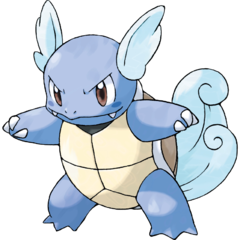

A light blue bipedal turtle with a light brown shell, it first evolves into a navy-blue version of itself with feathery ears and tail, and then into a massive, dark blue tortoise with two high-pressure water cannons jutting out of its back. The first Water-types of many, and the first pure-typed line, these guys are defense-based fighters, but, as a starter, they are quite well-rounded and can play both styles. It also has a diverse move pool of powerful Water, Ice, Normal, Ground, and Fighting-type moves, especially after Generation I, when they started to get support moves. Squirtle is the Normal difficulty of Gen 1. It is weak against two of the gyms, Erika and Surge, but it has advantages against three and is neutral against the rest. Blastoise gains a Mega Evolution in X and Y. As well as increasing its offenses and defenses, Mega Blastoise also does more damage with "pulse" moves.
In the "Isle of Armor" expansion of Sword and Shield, special Blastoise gain a Gigantamax form that increases their shell size and gives them 31 new water cannons.
Squirtle appears alongside Ivysaur and Charizard as the Pokémon Trainer fighter's trio of playable Pokémon in Super Smash Bros. Brawl, the 3rd entry of Nintendo's Massive Multiplayer Crossover Fighting Game series, and after being absent for the fourth game, came back in Super Smash Bros. Ultimate, alongside Ivysaur and rejoining Charizard. For tropes concerning its Smash incarnation, see the Super Smash Bros. Brawl character page.
- Arm Cannon: Mega Blastoise gets one on each arm.
- Attack of the 50-Foot Whatever: Blastoise’s Gigantamax form is over 80 feet tall.
- Backpack Cannon: Blastoise carries twin water cannons on its back. Its Mega Evolution exchanges those for a single, larger one. It gets at least 31 when it Gigantamaxes.
- Badass Back: Gigantamax Blastoise keeps its back turned to its opponents, the better to use its myriad cannons against them.
- BFG: The cannon it gets in its Mega Evolution is almost as long as Blastoise's body.
- Blush Sticker: Wartortle has indigo-colored blush marks on its face.
- Boring, but Practical: Base Blastoise is this, especially when compared to Base Charizard. It's not as flashy or offense-oriented, but because it has well-rounded stats and the best typing for the Gyms and Elite Four, it's the Pokémon of choice for veterans. It gets some flashy moves like Water Spout and Shell Smash that transform it into a powerful Mighty Glacier, but the former is an egg move and the latter is only available in Pokémon Sword and Shield, where Squirtle can only be obtained in the Isle of Armor DLC.
- Breakout Character: Not as much as Charizard, but both Squirtle and Blastoise are among the most recognizable Generation I Pokémon. Blastoise in particular is frequently marketed as The Rival to Charizard and ranks very closely in some popularity polls, while Squirtle is one of Ash's most beloved Pokémon in the anime and fights alongside Charizard as part of their Trainer's team in the Super Smash Bros. series.
- Confusion Fu: Blastoise has slowly, but surely gained a ton of moves through generations. As of Gen VIII, it learns the usual skillset of Water-type mons with Water-, Ice, and Normal-type moves, in addition to a good number of Ground-, Fighting-, Rock-, Dark-, Steel- and even Dragon-type moves. It even learns the odd Psychic-type move in Zen Headbutt and Confusion.
- Cute Little Fangs: Wartortle gains them upon evolution, but Blastoise seems to lose them again.
- Extra-ore-dinary: Blastoise can remember Flash Cannon if you take it to the Move Relearner. The entire line also leans Iron Defense.
- Healing Factor: Their Hidden Ability, Rain Dish, heals them by 1/16 of their total HP at the end of each turn if it is raining.
- Improbable Aiming Skills: According to the Pokédex, the water jets from Blastoise's cannons are accurate enough to hit empty cans from over 160 feet away. Mega Blastoise takes this further, with its larger cannon having a range of six miles.
- Kamehame Hadouken: As of Gen VI, they can learn Aura Sphere as an Egg Move and Mega Blastoise's ability boosts it further, making it a literal Kamehameha ("Turtle Destruction Wave").
- Land, Sea, Sky: Blastoise is the Sea to Venusaur's Land and Charizard's Sky.
- Lightning Bruiser: Blastoise can become this with Shell Smash, drastically improving its offenses and speed while retaining its solid defenses if used with a White Herb.
- Making a Splash: Water-types based off of turtles. Blastoise's water cannons are strong enough to break through concrete and steel walls.
- Meaningful Name: Zenigame (銭亀) means "baby pond turtle" or, more literally "coin turtle". Kameil is either a combination of "kame" (亀), meaning turtle
 , and the English word "tail," and/or is a pun on the word "kameru" (噛める), meaning "to be able to bite." Kamex seems to be a combination of "kame" and "max" (as in "maximum").
, and the English word "tail," and/or is a pun on the word "kameru" (噛める), meaning "to be able to bite." Kamex seems to be a combination of "kame" and "max" (as in "maximum"). - Mighty Glacier: Upon Mega Evolving, Mega Blastoise's Special Attack stat receives a large boost and its already good defenses are improved.
- Mix-and-Match Critters:
- Squirtle's curly tail resembles a cartoonized squirrel's, and the portmanteau of squirrel and turtle lends itself to the Punny Name of "squirt". Considering this pun is absent in the Japanese name, it's unclear whether this was by design or serendipity.
- Squirtle and Wartortle's appearance are actually based on Japanese legends of the minogame: a turtle who has lived so long that aquatic plants have fused to it to form a coat of grass, a long tail, and occasionally ears. Curiously, Blastoise ditches everything about the minogame in favor of going cyborgish turtle. Unlike most yokai, minogame — at least the part about algae growing a coat and secondary tail — actually can be found in real life, under certain conditions.
- More Dakka: Gigantamax Blastoise has 31 shell cannons.
- Ninja Pirate Zombie Robot: Gigantamax Blastoise is a skyscraper-sized battleship/fortress tortoise and the embodiment of More Dakka.
- Power Up Letdown: Just like with Charizard, Gigantamax Blastoise's G-Max Cannonade, while even more incredibly cool in concept, isn't nearly as useful for it as a normal Dynamax Blastoise's Max Geyser. Cannonade is merely a type-shifted version of G-Max Wildfire (dealing residual damage to all non-Water types), but Max Geyser summons rain, which not only boosts Blastoise's Water-type attacks, but can also let it restore HP with Rain Dish.
- Rain Dance: They can learn Rain Dance, which causes it to start raining in battle for five turns.
- Recurring Element: Kicked off the tradition of a built-in third member of a mascot duo to later receive its own game, with Red & Green and later Blue Version in Japan. This trend wouldn't be invoked properly until Gen III, as Gen II had a true duo, with the third game's mascot unrelated to the theme.
- Ridiculously Cute Critter: Just like most starters, Squirtle is a round, adorable baby turtle that becomes more intimidating once it evolves.
- The Rival: Marketing treats it as a rival to Charizard, particularly when the player chooses the Charmander line. This is one of the reasons why it isn't the mascot of the Gen III remakes. Releasing a Fire and Water pair of games felt too combative compared to Fire and Leaf.

- Secret Art:
- Hydro Cannon was exclusive to Blastoise before XD, and nowadays it is the Secret Art of the fully evolved Water starters. Water Pledge, too, as it is a Water Starter. Notably, it's the only starter Pokémon to use Water Spout, one of the most powerful Water-type attacks in the game.
- Gigantamax Blastoise has G-Max Cannonade, a move that does four turns of extra damage to all non-Water types.
- Shed Armor, Gain Speed: With Shell Smash.
- Shock and Awe: A special Squirtle distributed during Gold, Silver, and Crystal came with the move Zap Cannon, a powerful Electric-type attack that always paralyzes the target if it hits with its 50% accuracy.
- Signature Move: While the move is very widespread, Blastoise is heavily associated with Hydro Pump because that's what its cannons are practically meant for.
- Spin Attack: Can learn Rapid Spin., which removes entry hazards and boosts their speed.
- Spin to Deflect Stuff: Rapid Spin is a retroactive form, removing stage hazards and binding moves when used.
- Starter Mon: One of the starter Pokémon of Kanto. Squirtle is Gen I's "medium mode" since it fares well at the first gym but neutral at the second, and runs into problems with the third and fourth. It can also be obtained early in Pokémon X and Y.
- Status Buff: Contrasting Charizard, it used to learn purely defensive ones in Withdraw and Defense Curl (which are functionally the same) and Iron Defense. Gen VII gave them Work-Up to boost both attacking stats, and Gen VIII finally gave them Shell Smash to make them far more powerful and faster, but at the cost of its defenses.
- Stone Wall: Blastoise has good defensive stats, but its offensive stats are quite average.
- Super Mode:
- Gained a Mega Evolution in Gen VI. Mega Blastoise gains the new Ability Mega Launcher, which boosts the power of the attacks Water Pulse, Dark Pulse, Dragon Pulse, and Aura Sphere, all of which it is now capable of learning.
- Gen VIII DLC gives it a Gigantamax form, turning its Water-type moves into G-Max Cannonade, which inflicts passive damage on non-Water-type Pokémon for several turns.
- Tail Slap: Can learn Aqua Tail.
- Tank Goodness: Mega Blastoise resembles an army tank with its bulky body and single huge cannon. Blastoise in general is even called "Tortank" in France.
- Time Abyss: Wartortle is said to live 10,000 years.
- Turns Red: Torrent boosts its Water attacks when its health becomes low.
- Weaponized Animal: Blastoise, for some reason, obtains cannons upon evolution.
- Wise Old Turtle: Wartortle is extremely long-lived: its Pokédex entries have noted it to be an In-Universe symbol of longevity since the first generation games, and later ones specify it as having a lifespan of 10,000 years.
- "X" Makes Anything Cool: Blastoise's Japanese name is just the Japanese word for turtle with an added "X" at the end, although it could also be a pun on "max".
0010: Caterpie (キャタピー kyatapii)
0011: Metapod / Transel (トランセル toranseru)
0012: Butterfree (バタフリー batafurii)
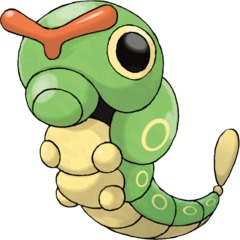
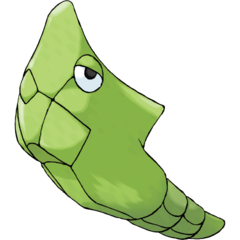

A green caterpillar with red antennae and an eye-like pattern, it looks like a Spicebush Swallowtail caterpillar (which uses mimicry to resemble a snake). Its evolution goes along as metamorphosis, first becoming a green chrysalis, then a purple-bodied, blue-winged butterfly. The first Bug-types in the Pokédex, and first common Mons, these are used fairly commonly early in-game before being ditched. It is mostly used as a status inducer, but, like most butterfly and moth Pokémon, also learns Psychic attacks, and thus is a good alternative to a proper Psychic Pokémon until one can be obtained.
A special Butterfree caught in a Raid Battle in Galar has the ability to Gigantamax, giving it access to the Bug-type G-Max Befuddle, which has a chance to induce the sleep, paralysis or poisoned condition on the opposing Pokémon.
- Achilles' Heel: Rock-type moves will squash Butterfree like a bug.
- Attack of the 50-Foot Whatever: Gigantamax Butterfree is 55 feet tall.
- Balance Buff: Butterfree got a 10 point boost to its Special Attack in Gen VI, bringing it up to 90.
- Big Creepy-Crawlies: First Bug-types in the Dex. Plus, Butterfree is 3'07".
- Big Eater: Caterpie, unsurprising if you know anything at all about caterpillars. The Hoenn Pokédex entries state that it eats leaves bigger than itself "without hesitation", and Ultra Sun states that it eats 100 leaves a day. Sword & Shield has it eating portions of curry meant for large-sized Pokémon.
- Blow You Away: Another odd case of the type, as it actually had zero Flying-type moves to work with in Gen I - at least it could learn Razor Wind and Whirlwind. Later gens have changed this with the addition of Tailwind, Hurricane, Air Slash and Roost.
- Com Mons: The early areas of Kanto and Johto are filled with them.
- Crutch Character: Fully evolves at level 10 and learns the powerful (for the early game) Confusion, it typically outclasses anything else available at that point. It quickly falls behind the power curve as other Mons evolve, but lasts longer in this role compared to many other early game Bug Pokémon thanks to its various "powder" attacks giving it utility as a status spreader and helping to catch other wild Pokémon. With the addition of its "Compound Eyes" ability in Gen III which boosts the accuracy of its status-inducing moves, it comes to border on a Disc-One Nuke but still eventually becomes outclassed due to its low stats and poor typing with plentiful weaknesses.
- Flight: Butterfree, thanks to being part Flying-type, although it can't learn Fly.
- Foil: To the Weedle line — both are insect-based Pokémon lines that consist of a larval stage (Weedle and Caterpie), a pupa stage (Kakuna and Metapod), and an adult stage (Beedrill and Butterfree), but Beedrill is a dangerous and threatening creature while Butterfree is more docile and beautiful. Beedrill focuses on physical attacks and Damage Over Time with its Poison moves, while Butterfree primarily uses special attacks and status moves, both to strengthen itself and cripple the opponent. Finally, Butterfree got a Gigantamax form while Beedrill got a Mega Evolution.
- Glass Cannon: Quiver Dance Butterfree can easily ruin the day of an unprepared opponent, but it needs to play for keeps. Any strong physical hit will bring it down, and its massive weakness to Stealth Rock makes bringing it into play even harder.
- Item Caddy: If the first Pokémon in the party has the Compound Eyes ability (like Butterfree does), it increases the chances of encountering wild Pokémon holding items. Butterfree also gets Thief via TM to relieve them of said items.
- Informed Ability: The various Pokédex entries of Butterfree mention that it is adept at collecting honey, but it doesn't have Honey Gather as one of its Abilities.
- Lethal Joke Character: Past the early-game, Butterfree is an extremely frail and weak Pokémon, but it can learn Quiver Dance (To boost its weaker stats), Hurricane, and Sleep Powder. It also has the ability Compound Eyes which raises its accuracy. An unprepared opponent can find themselves on the ropes if they underestimate the little guy.
- Mama Bear: Butterfree are protective of Caterpie, and will dump poison on any Bird-Pokémon that tries eating them.
- Meaningful Name: Caterpie is derivative of "caterpillar". Transel combines "transform" with "cell", while "Metapod" combines "metamorphosis" with "pod". Butterfree is derivative of "butterfly".
- Palette Swap: One of the very first Pokémon to be featured with a color scheme that was different from the norm. In the anime, Ash's Butterfree met and fell in love with a Butterfree with a pink body, signifying that yes, this is a girl Butterfree. A little later, Butterfree that lived in the Orange Islands were shown to have wings with different markings. Strangely, none of them are officially their shiny forms, which debuted a generation later.
- Pretty Butterflies: Butterfree by itself doesn't fit, but its Gigantamax form is another story due to its colorful wings.
- Psychic Powers: Butterfree, in a possible Shout-Out to Mothra, can learn Confusion and Psybeam by leveling up, and other Psychic moves through TM.
- Razor Wind: Butterfree learns the aptly named move alongside Air Slash and Air Cutter.
- The Rival: Butterfree are known to fight over territory with Cutiefly.
- Scissors Cuts Rock: Invoked by Tinted Lens, which doubles damage against Pokémon that resist their moves - basically making Butterfree hit for neutral damage against most targets.
- Situational Damage Attack: Learns Venoshock and Facade, which increase in power when used against a poisoned Pokémon and if Butterfree itself is statused, respectively. Don't expect it to hit any hard even with max power Facade, tho.
- Status Buff: They learn Harden and Iron Defense as Metapod, and Butterfree gets the amazing Quiver Dance to boost its special and speed stats.
- Status Effects:
- Poison Powder, Stun Spore, and Sleep Powder. Other Pokémon get them as well, but Butterfree's one of the more common abusers due to Compound Eyes making them far more accurate than when used by other Pokémon.
- Sure enough, Gigantamax Butterfree's signature move G-Max Befuddle is based on Butterfree being associated with the three powders, as it imposes poison, paralysis, or sleep on each opponent when it hits.
- Super Mode: Butterfree attained from Max Raid Battles may have Gigantamax potential, and those specimens can use G-Max Befuddle to inflict either Poison, Paralysis or Sleep on their targets.
- Support Party Member: Though it falls well behind the power curve by mid-game, its utility as a particularly accurate status inducer can allow it to stick around in this role deep into the game, particularly in Nuzlocke challenges.
- Vibration Manipulation: Learns Supersonic and Bug Buzz, which are both sound-based moves.
- Weak, but Skilled: Despite its overall weak stats, Butterfree learns a lot of status moves, has Compound-Eyes to boost their accuracy, and also Quiver Dance to help it on the strength department. Invoked by its Hidden Ability Tinted Lens, which makes its not-very-effective moves double their damage against their targets.
- You Have Researched Breathing: In Red and Blue, a Metapod evolved from a Caterpie cannot learn Harden. Conversely, wild Metapod can only learn Harden. This is rectified in Yellow, where they automatically learn Harden as long as Caterpie evolves at Lv. 7.
0013: Weedle / Beedle (ビードル biidoru)
0014: Kakuna / Cocoon (コクーン kokuun)
0015: Beedrill / Spear (スピアー supiaa)
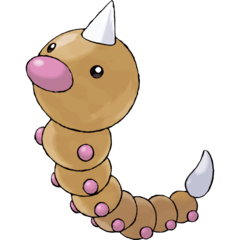
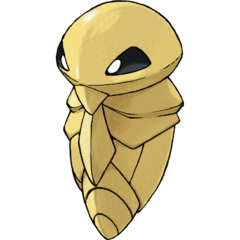

A yellowish Bug-type worm with a poisonous stinger on the top of its head, it also experiences a metamorphosis, first turning into an immobile yellow nymph, then into a giant poison bee with 2 additional stingers as hands. It has many things in common with the Caterpie line and is always found at the same locations, but encounter rates tend to change with versions. Beedrill itself is a physically-based Pokémon, and it is also able to learn stat-boosting moves and pass them to other teammates. However, those moves are not obtainable at low levels, and thus its usefulness is reduced in comparison to Butterfree. In Omega Ruby and Alpha Sapphire, Beedrill gained a Mega Evolution that gives it the STAB-boosting Adaptability ability.
- Balance Buff:
- The addition of Mega Beedrill greatly improved Beedrill's chances in a fight. It also came with a slight buff to base Beedrill's attack in Gen VI - 10 points, bringing it up to an acceptable 90.
- Mega Beedrill is the Pokémon that benefits the most from the rule changes in Generation VII concerning Mega Evolution: On the turn a Pokémon Mega Evolves, if that Pokémon's Speed changes, turn order is determined based on the new Speed on that turn rather than the following turn. With an increase in Speed from base 75 to 145, this allows Mega Beedrill to dart ahead right away instead of waiting a turn and risking getting knocked out before it can attack.
- Bee Afraid: Beedrill. Would you want swarms of three-foot-tall bees at your picnic?
- Big Creepy-Crawlies: Beedrill is a 3-foot-tall hornet/bee thing.
- Big Eater: Weedle, like Caterpie, which makes sense being a larva. Weedle eats its weight in leaves every day.
- Blow You Away: Learns a variety of Flying-type moves like Acrobatics, Aerial Ace, Defog, Tailwind and Roost. It is also one of the few Pokémon to be depicted as flying in their sprite/animations, yet is not immune to Ground-type moves.
- Cherry Tapping: Generation VI gave it the move Fell Stinger, an attack with a paltry 50 Power. However, if Beedrill successfully KOs an opponent with it, it drastically raises its Attack.
- Combat Pragmatist: Learns a variety of Dark-type moves: Knock-Off, Pursuit, Assurance, Thief, Throat Chop, Assurance and Payback.
- Com Mons: Weedle are found very early on in the games it appears in and tend to be common, but its stats are nothing special.
- Critical Hit Class: Beedrill has access to Focus Energy and Sniper, which can be used with a Scope Lens to give a 2.25x power boost to all of its attacks.
- Crutch Character: Like the Caterpie family, its overall stats are rather low for a fully evolved Pokémon. What's more, Beedrill doesn't have the special status effect moves Butterfree enjoys, relying on pure damage attacks during its usable time-span. The introduction of Mega Beedrill gave it much more lasting power, however.
- Dump Stat: Beedrill's stat gains from Mega Evolving are funneled entirely into Attack and Speed; its defenses don't get any boosts, and its Special Attack actually gets a thirty-point deduction.
- Early Installment Character-Design Difference: Kakuna's original sprite shows its arms, as does early official art. Since then, its arms are always depicted tucked away.
- Exactly What It Says on the Tin: Kakuna's Japanese name is Cocoon.
- Expy: Weedle is a Wiggler, but with a stinger instead of a flower.
- Flight: Kakuna gains wings when it evolves into Beedrill and so it flies above the ground.
- Foil: To the Caterpie line — both are insect-based Pokémon lines that consist of a larval stage (Weedle and Caterpie), a pupa stage (Kakuna and Metapod), and an adult stage (Beedrill and Butterfree), but Beedrill is a dangerous and threatening creature while Butterfree is more docile and beautiful. Finally, Butterfree got a Gigantamax form while Beedrill got a Mega Evolution.
- Gameplay and Story Segregation: Beedrill is constantly depicted as flying above the ground in sprites and 3D animations, yet remains equally vulnerable to Ground. Even more jarring with Mega Beedrill, who doesn't even have legs to stand on the ground.
- Glass Cannon: It has decent Attack and Special Defense with passable Speed, but the rest of its stats are low. Upon Mega Evolving, Mega Beedrill becomes a Fragile Speedster, giving it staggeringly huge boosts to its Attack and Speed but retaining the bad defenses. On top of that, Mega Beedrill gains Adaptability, which boosts STAB moves.
- Keep It Foreign: The Japanese version uses the English word Cocoon while the English version uses the Japanese-sounding Kakuna.
- Magikarp Power: An interesting double-subversion. Weedle and Kakuna are pretty much useless, apart from Poisoning opponents. Beedrill is powerful for how early you can get it, but quickly falls behind once your other Pokémon start evolving. However, Mega Beedrill is a terrifying Glass Cannon with immense Attack and Speed stats, and hits incredibly hard with its Adaptability-boosted Bug- and Poison-type moves.
- Meaningful Name: Cocoon is Exactly What It Says on the Tin. Spear references the spear-like shape of its stingers.
- Min-Maxing: Mega Beedrill's already weak Special Attack drops even further so more points can be added to its Attack and Speed without violating the "no total stat increase greater than 100" rule of Mega Evolution.
- Multi-Armed and Dangerous: Mega Beedrill has four stinger arms, with its legs having turned into the second pair.
- Poisonous Person: A Poison-type larva that becomes a cocoon, then a bee. It naturally learns Poison Sting, and Beedrill's Secret Art, Twineedle, can also poison foes.
- Sdrawkcab Name: Beedrill's Japanese name, スピア Supia (Spear), spelled backwards in katakana is アピス Apis, the scientific genus of the honey bee.
- Secret Art: Twineedle for Beedrill, although it is no longer exclusive to it as of Black and White.
- Super Mode: Beedrill gets access to a Mega Evolution in Omega Ruby and Alpha Sapphire. Its Attack and Speed get massive boosts at the cost of some Special Attack, and it receives the Adaptability ability to increase the damage of its STAB attacks.
- Super-Speed: Learns the speed-boosting Agility by level-up.
- They Call Him "Sword": Beedrill's Japanese name is simply "Spear".
- This Is a Drill: Beedrill can learn Drill Run, which has an increased chance of landing a critical hit.
- Turns Red: Swarm boosts their Bug attacks when they're at 1/3 health or lower.
- Wicked Wasp: Beedrill takes some design cue from wasps as well as bees, and many of its Pokédex entries emphasize its viciousness.
- You Have Researched Breathing: In Red and Blue, a Kakuna evolved from a Weedle cannot learn Harden. Conversely, wild Kakuna can only learn Harden. This is rectified in Yellow, where they automatically learn Harden as long as Weedle evolves at Lv. 7.
0016: Pidgey / Poppo (ポッポ poppo)
0017: Pidgeotto / Pigeon (ピジョン pijon)
0018: Pidgeot / Pigeot (ピジョット pijotto)

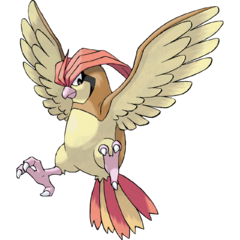
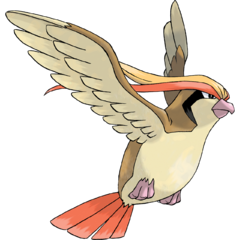
A brown Normal/Flying type bird with a cream-colored belly and elements of both pigeons and birds of prey, still in the chick stage, that evolves into a quite large, more mature version of itself with a small red crest of feathers, and then into a human-sized version of itself with the crest now going all the way down its back. The first Normal-types in the Dex, and also often one of the first Pokémon caught by anybody in the Kanto and Johto games. Their stats are fairly balanced and not weak in any particular regard, but, sadly, they are not very strong in any particular regard either. Still, it tends to be a staple of in-game teams, since somebody has to be on Fly detail. In Omega Ruby and Alpha Sapphire, Pidgeot gained a Mega Evolution with No Guard.
- Always Accurate Attack: Mega Pidgeot's ability is No Guard, which makes it so all attacks that it uses or target it into these. Which means its Hurricane will never miss. They can also learn Aerial Ace, Swift, and Feint Attack, which bypasses accuracy check.
- Balance Buff: Pidgeot was given a 10 points buff to Speed starting in Gen VI, making it more of a Fragile Speedster.
- Blow You Away: Has had Gust and Whirlwind as trademark moves since the very beginning (even having the former as an exclusive move prior to Yellow), and has since added Air Cutter, Aerial Ace, Air Slash, Tailwind, Twister, Hurricane and even Heat Wave (which is called "Hot Wind" in Japanese) to its repertoire.
- Boss Battle:
- Pidgeotto is the first gym boss of Gen II/IV as Falkner's signature, but being a Com Mon that's not even fully evolved, having an offensive advantage against just one of the starters, and only at level 9 in the original games, it's really a Zero-Effort Boss. Mitigated somewhat it the remakes, where it's bumped up to level 13.
- The Pidgey family is also a favorite of Blue, who usually leads with it, has it as his best Pokémon, or has it play Number Two to his chosen starter if he has one. In Red, Blue, and Green and their remakes, Blue uses a Pidgey from his second fight onward to provide Sand-Attack and boosted Normal- and Flying-type attacks, which can cause serious trouble for players who try fighting him with a solo starter.
- Casting a Shadow: They can be tutored to know Ominous Wind, a Ghost-type move.
- Com Mons: Found in almost all of the routes of Kanto and Johto.
- Death or Glory Attack: Double-Edge and Brave Bird, which hit hard but makes them take 33% of the damage dealt. They also gain STAB on the moves.
- Drunken Master: Their Tangled Feet Ability increases Evasion while they're Confused.
- Feathered Fiend: Pidgeotto are said to be fairly territorial.
- Flight: They're birds, so it's a given.
- Foil: To the Spearow line. Both are Com Mon birds whose first form is classified as a "Tiny Bird" Pokémon and have larger, more predatory evolutions. However, Spearow contrasts with Pidgey by being more wild and unpredictable, while Fearow contrasts with the bulky-looking Pidgeotto and Pidgeot by being Lean and Mean. The biggest difference between them is that the Spearow line is a two-tier evolution rather than a three-tier one.
- Fragile Speedster: Pidgeot has impressive Speed, which becomes even faster after Mega Evolution, but can't take many hits.
- Giant Flyer: Pidgeot is a flying bird, complete with a compact build, as tall as an emu. Mega Pidgeot has a height (or wingspan) of 2.2 meters/7 feet three inches, the same average wingspan of a whooping crane. That's one big bird.
- Glass Cannon: Mega Pidgeot has an impressive 135 base Special Attack, but it only receives a small boost to both of its defenses. No Guard, the ability Mega Pidgeot obtains upon Mega Evolving, doesn't help matters.
- Heal Thyself: Naturally learns Roost, which restores half of its maximum HP.
- Informed Ability: Most of its Dex entries say that Pidgeot can fly as fast as Mach 2. In-game, however, its base speed is only slightly above average (lower than Miltank's, a cow). Even after Gen VI gave it a small permanent boost to Speed, it's still not that impressive.
- Kubrick Stare: Pidgeotto has a permanent one in Pokémon GO.
- Master of None: None of Pidgeot's stats are high enough to focus on, its typing is very common, and its movepool is historically rather lackluster (up until the fourth generation, Hidden Power was one of its only sources of Flying STAB). This is particularly true in the first generation, where it has to compete with Fearow and Dodrio, which aren't much less bulky, boast better Speed, and hit much harder thanks to higher Attack and Drill Peck. The sixth generation somewhat mollified this by giving it an extra 10 Speed, but it's only with its Mega Evolution that Pidgeot stands much chance next to any other bird. However with the removal of Mega Evolutions in Gen 8, Pidgeot has fallen right back into this.
- Meaningful Name: Poppo comes from the Japanese sound of a pigeon cooing ("poppoppo"). Pigeon is just what it says (despite looking nothing like a pigeon). Pidgeot combines "pigeon" and "jet."
- Multiform Balance: Pidgeot hits harder on the physical side than on the special side, fitting for a Gen I Normal/Flying-type since both of those types were physical prior to Generation IV, while Mega Pidgeot is far stronger with special moves.
- Muscles Are Meaningful: Entire line has the Big Pecks ability, which protects them from defense-lowering status moves.
- Noble Bird of Prey: Pidgeotto and Pidgeot are based on ospreys and eagles, respectively, and are known for hunting Magikarp.
- Non-Elemental: The first Normal-types in the Pokédex. Ironically, they lacked the expansive moveset typical of the type in Gen I, probably as a form of balance.
- Non-Indicative Name: Pidgey has relatively little in common with pigeons, more strongly resembling finches and sparrows. Pidgeotto and Pidgeot have even less in common with pigeons; Pidgeotto looks and acts more like some kind of hawk while Pidgeot more resembles an eagle or an osprey (the latter due to its diet consisting mostly of fish). It's much more glaring with the introduction of the Pidove line, which is also named after pigeons but actually looks the part.
- No-Sell: Pidgeot is among the few Pokémon that can deal with the armored scales of Magikarp.
- Playing with Fire: They can all learn Heat Wave by Move Tutor.
- Power Copying: They can learn Mirror Move, which allows them to use the last move the opponent used on them for the duration of the battle.
- Power Makes Your Hair Grow: While some of Mega Pidgeot's crest becomes shortened and spiky, one part becomes a long trailing feather that trails the length of Mega Pidgeot's body.
- Razor Wind: They have moves like Air Cutter and Air Slash at their disposal. Air Cutter has an increased chance of landing a critical hit, while Air Slash has a 30% chance to cause their opponent to flinch.
- Secret Art: The only Pokémon that naturally learn Feather Dance prior to Pokémon X and Y.
- Stock Animal Diet: Invoked in spirit — Pidgey eats bugs like a typical small bird would; Pidgeotto is mentioned to like eating Exeggcute, referencing birds that eat fruit and seeds; and Pidgeot eats fish, like an eagle.
- Super Mode: Pidgeot receives a Mega Evolution in Omega Ruby and Alpha Sapphire. Its Special Attack and Speed get substantial boosts, its defenses are slightly buffed, and it gets the No Guard ability to ensure its moves never miss.
- Super-Senses: The Keen Eye ability negates all attempts to reduce a Pidgey-family Pokémon’s accuracy, and in more recent games, also ignores all attempts to raise an enemy Pokémon’s evasion.
- Super-Speed: It can learn the speed-boosting move Agility.
- Trademark Favorite Food: Each one has something of its own niche in the food chain of the Pokémon world; Pidgey usually feeds on bugs, Pidgeotto is noted to hunt Exeggcute, and Pidgeot specializes in plucking Magikarp from rivers. This is actually shown in a Pokémon: Magikarp Jump random event where your Magikarp gets carried away by a Pidgeotto and "Forcefully Retired".
- Utility Party Member: The first Pokémon you find that can learn Fly if you didn't pick Charmander as your starter.
- When All You Have Is a Hammer…: Mega Pidgeot does not get that many moves in its learnset to actually take advantage of No Guard. It gets only 12 moves with less than 100% accuracy (which No Guard does not help with unless Accuracy or Evasion modifiers are in play), of which 9 have at least 90% accuracy, 2 have 85% accuracy, and only one has 70% accuracy. Despite the limited amount of moves in which No Guard actually makes a difference, it's that single move with 70% accuracy, Hurricane, that allows Mega Pidgeot to actually take advantage of its ability as it's its strongest, no-recharge, special move by a very large margin.
0019: Rattata / Koratta (コラッタ koratta)
0020: Raticate / Ratta (ラッタ ratta)
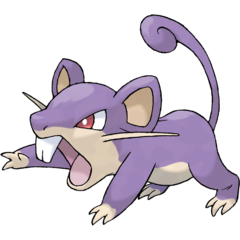

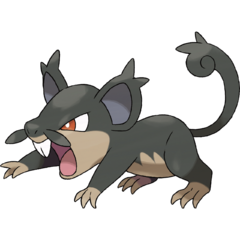

A purple, Normal type rat with a cream-colored belly that evolves into a brown-backed, cream-bellied nutria/musk rat. The first line in National Dex order made up of two rather than three stages, they are one of the most common species in Kanto and especially Johto, being found in pretty much all Routes and a few caves. In battle, they are rather fast (though not absurdly so), but statistically unremarkable otherwise from the get-go. However, they learn strong moves early on, and tricky moves later, that, combined with their traits, makes them competent, if unconventional, fighters.
In the Alola region, Rattata started to swarm the region to the point that the locals brought in Yungoos from another region to deal with the problem. To counteract their new predator, they altered their habits to become nocturnal creatures so that they can avoid Yungoos, who are mostly active during the day. In the process they became part Dark type. Alolan Rattata are led by Alolan Raticate, who are much fatter than regular Raticate due to having a diet that is higher in calories and getting their Rattata subordinates to gather that food for them. Unlike their Kanto counterparts, Alolan Rattata and Raticate are extremely picky eaters, preferring to eat fresh and high-class foods.
- Acrofatic: The Totem Alolan Raticate has no problem performing a flip as it jumps down from a ledge to battle the player character.
- Adipose Rex: Alolan Raticate send out Alolan Rattata to gather food while they stay behind to eat.
- Animal Facial Hair: Alolan Rattata have black whiskers that resembles a mustache.
- Armor-Piercing Attack: Super Fang halves the current HP of the target. No exceptions. Unless it's a Ghost.
- Big Eater: Regular Rattata are generally not fussy eaters, but Alolan Rattata can have Gluttony as an ability.
- Boss Battle: In Moon and Ultra Moon, a Totem Alolan Raticate is the first Totem Pokémon you fight in the game.
- Cherry Tapping: One Battle CD in Pokémon XD: Gale of Darkness pits a level 5 Rattata vs. a level 100 Shuckle. This strategy is required to win.
- Combat Pragmatist: They get several Dark-type moves. Alolan Rattata and Raticate are part Dark-type.
- Com Mons: Found everywhere in Kanto, Johto, and Alola.
- Commonplace Rare: Despite being the archetypical early-game mammal that is everywhere, Rattata cannot be found in Kalos at all. Not even in the Friend Safari. It can only be obtained through transfer and trading from Omega Ruby and Alpha Sapphire.
- Confusion Fu: The Normal-type Pokémon to start the trend of expansive learnsets. In Gen I, it learned Blizzard, Thunder and Water Gun, with latter gens bumping their learnset to 15 out of the 18 types. It only misses on Dragon-, Rock-, and Fairy-type moves.
- Crouching Moron, Hidden Badass: Raticate can combine a Toxic Orb or Flame Orb with its Guts ability to throw out brutally powerful Facade attacks.note In tandem with some other moves for coverage, Raticate is surprisingly powerful... but it still takes hits like a damp piece of paper, not helped by its health being slowly whittled down with the orb.
- Crutch Character: Hyper Fang is twice as strong as most attacks you are using by the point you get it, and Raticate has the Speed and Attack to use it effectively, only being hampered by slightly low Accuracy. It gets overshadowed later when other things also get strong moves, but it may even step into being a Disc-One Nuke if you play with its additional tricks.
- Death or Glory Attack: Can learn Double-Edge, which deals massive damage at the cost of a bit of HP.
- The Don: Alolan Raticate appears to be intended as a crime lord. This fittingly contrasts with Gumshoos, who looks like a Hardboiled Detective.
- Explosive Breeder: Rattata, according to the Pokédex: "It eats everything. Wherever food is available, it will settle down and produce offspring continuously."
- Fantastic Vermin: Much like real rats, they're pests who eat almost anything and are Explosive Breeders in locations with lots of food. This is especially so for the Alolan variants, which were introduced to the islands by mistake and quickly became invasive.
- Fat Bastard: Alolan Raticate is meant to invoke this by acting as a rotund, unsavory crime lord who sends its Alolan Rattata underlings out to steal food.
- Foil: The Alolan variants is a foil for Gen VII Pokémon Yungoos and Gumshoos. They have a predator/prey relationship, a day and night motif, and a Gangster/Detective motif.
- Four Legs Good, Two Legs Better: Alolan Rattata usually stand on two legs, unlike regular Rattata, who usually stand on four.
- Fragile Speedster: Speed is their highest stat. Rattata in particular is very fast for an unevolved, early game Com Mon. They don't take hits well, though.
- Glass Cannon: Raticate with an activated Guts or Hustle can have the power and speed of Haxorus, at the cost of losing a chunk of HP every turn or missing 20% of the time, respectively.
- Kevlard: The fatter Alolan Raticate has better HP and defenses than regular Raticate, and has Thick Fat as its Hidden Ability.
- King Mook: In Moon, a Totem Alolan Raticate appears in Verdant Cavern as part of a trial. Sun swaps it out for a Totem Gumshoos.
- Master of None: Alolan Raticate's stats range from 70 to 80, except for its low Special Attack. While it's not as fragile as regular Raticate, none of Alolan Raticate's stats are especially good.
- Meaningful Name:
- Rattata is a combination of "rat" and "attack," and seems to be taken from its beta name, Rattatak. Raticate combines "rat" with "eradicate."
- Koratta adds "ko" (子 "child" or 小 "small") to "Ratta," which is taken from "rat."
- Misplaced Wildlife: Much like real-life rats in Hawaii, they were accidentally brought into Alola at some point, and began to run so rampant that the local government imported Yungoos and Gumshoos in a misguided attempt to control them. Of course, this only resulted in a Yungoos/Gumshoos problem in the day and an Alolan Rattata/Raticate problem in the night.
- Nocturnal Mooks: Alolan Rattata and Raticate only appear in the wild at night, being replaced by Yungoos and Gumshoos during the day.
- Non-Elemental: The first pure Normal-type in the Pokédex. Their Alolan counterparts have Normal as their secondary types.
- Picky Eater: Unlike their cousins elsewhere in the world, Alolan Rattata won't eat anything that isn't fresh. Alolan Raticate are so picky that a high class restaurant is rumored to use it to choose ingredients and taste test new dishes.
- Playing with Fire: Flame Wheel can be bred on to them.
- Psychic Powers: Zen Headbutt can be bred onto them, allowing them to effectively deal with their Fighting-type weakness.
- Put on a Bus: Alolan Rattata and Alolan Raticate haven't been usable in a main series game since Pokémon Let's Go, Pikachu! and Let's Go, Eevee! in 2018.
- Rat King: Going by the description of Alolan Rattata, it seems as though Alolan Raticate are this. Not to mention, an Alolan Raticate serves as a Totem Pokémon boss in Pokémon Moon and summons Alolan Rattata to assist it in battle.
- Recurring Element: Two-folded. The Rattata line started the trend of an early two-stage rodent in every generation, while the Alolan line fits on the "early two-stage dark-type mammal" archetype.
- Rodents of Unusual Size: Raticate weighs over 40 lbs/18 kg. Alolan Raticate manage to be even heavier.
- Secret Art: Super Fang and Hyper Fang, although no longer exclusive as of Gen IV.
- Status Buff: Learns Defense Curl, Work-Up, Focus Energy and Swords Dance. Alolan Raticate adds Bulk-Up and Stockpile to the mix.
- Stealth Clothes: Alolan Rattata's whiskers evoke this, contrasting with Gumshoos's detective motif.
- Technicolor Eyes: Both Kantoian and Alolan Rattata have red pupils, but while the pupils of Raticate turn black upon evolution, the Alolan Raticate's pupils remain red.
- Underground Monkey: In response to the newly introduced Yungoos, the Rattata and Raticate of Alola were confined to the cities and became nocturnal, making them part Dark-type.
- Unskilled, but Strong: Hustle increases the power of their physical attacks by 50%, but lowers the accuracy of physical attacks by 20%.
- Useless Useful Spell: Raticate's colorful special moveset is brought down by its pathetic Special Attack of 50/40.
- Weak Sauce Weakness: The Alolan line will easily fall against Fighting-type moves.
- You Dirty Rat!: In comparison to the Pikachu family. Their Alolan forms emphasize this trait even more by being part Dark-type.
0021: Spearow / Onisuzume (オニスズメ onisuzume)
0022: Fearow / Onidrill (オニドリル onidoriru)
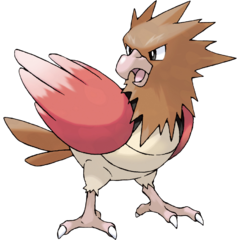

An alternative if you don't want to use Pidgey. Like Pidgey, it is a bird-like Pokémon with a Normal/Flying typing. Unlike the passive Pidgey, however, Spearow are pretty mean and scrappy birds. Spearow is supposed to resemble a sparrow, with a bit of crow mixed in; it has short wings and a short beak. Fearow, on the other hand, has longer wings and a longer beak, and it looks more like a vulture or a crane. Also unlike the Pidgey family, they're more physically-oriented, using their beaks to use moves like Drill Peck and Drill Run.
- Adaptational Villainy: The anime presents them as more or less Always Chaotic Evil, despite the games never claiming that they're any more or less dangerous than Pidgey and its evolutions. Heck, Pidgeotto is said to be more aggressive than Spearow and Fearow. Like how Raichu is treated in the anime, the Spearow line's antagonism is traced back to them assaulting Ash and Pikachu in the very first episode, as well as being hostile to the Pidgey line as a whole. However, this behavior is true to their names.
- Big Eater: Some of Spearow's Pokédex entries state that it has a voracious appetite for bug Pokémon. According to its Moon Pokédex entry, this makes them valued by farmers.
- Blow You Away: Flying-type bird Pokémon with moves like Razor Wind and Whirlwind.
- Boring, but Practical: They don't get much more "bland but effective" than the Spearow line, especially in Kanto. It's a very generic Normal/Flying bird Com Mon that can be caught within the first half-hour of gameplay, but it starts out with the Flying-type move Peck, has solid Attack and Speed, gets the best Flying-type move in the first three generations (Drill Peck) faster than any of its contemporaries, and can pretty much kill any Grass, Bug, or Fighting type you need it to throughout the entire game and serve as your aerial steed once you get Fly. Spearow and Fearow might not get the job done in style, but they will get the job done.
- Combat Pragmatist: Can learn Pursuit, which deals double damage if their target switches out and Assurance, which deals double damage if the target's already taken damage on the same turn it's used.
- Com Mons: Spearow is common, though not as much as Pidgey.
- Critical Hit Class: In addition to having Sniper as a hidden ability, which increases critical hit damage, Gen VII's introduction of Z-Crystals gave it access to Z-Tailwind, which gives it a big crit rate boost along with Tailwind's speed buff. Do not underestimate the Com Mons.
- Crutch Character: Useful early on, since Spearow is stronger than Pidgey, and actually starts with a Flying type move (since the Pidgey line needs to reach level 31 to learn Wing Attack in Red and Blue and level 9 to learn Gust in Gold and Silver onwards), making it useful against all the Bug-types you'll meet in the first few areas of the game. Unlike the Pidgey line (who doesn't evolve into its final stage until level 36), Spearow also evolves into the powerful Fearow fast at only level 20. However, Fearow is still quite weak compared to most fully-evolved Pokemon, and in its debut generation, is thoroughly outclassed by Dodrio and the legendary birds, who make much better Flying-type options for the late game.
- Feathered Fiend: They are very dangerous birds indeed. The anime recurrently portrays both as violent bully Pokémon who attack the cast in flocks.
- Flight: Another bird Pokémon, so yeah.
- Foil: To the Pidgey line. Both are Com Mon birds whose first form is classified as a "Tiny Bird" Pokémon and have larger, more predatory evolutions. However, Spearow contrasts with Pidgey by being more wild and unpredictable, while Fearow contrasts with Pidgeotto and Pidgeot by being thinner and more intimidating. The biggest difference between them is that the Spearow line is a two-tier evolution rather than a three-tier one.
- Fragile Speedster: Fearow has good Speed, but its defenses are below average.
- Glass Cannon: Has okay Attack and Speed, but low defenses.
- Heal Thyself: They can learn Roost, which restores half of their maximum HP.
- Jerkass: As explained in the Kanto Pokédex:Pokédex: Spearow, the Tiny Bird Pokémon. Unlike Pidgey, Spearow has a terrible attitude. It is very wild and will sometimes attack other Pokémon and humans.
- Lean and Mean: Fearow are aggressive and incredibly skinny.
- Meaningful Name: Onisuzume combines "oni" (鬼 "ogre, demon", referring to the evolutionary line's mean disposition) with "suzume" (雀 "sparrow"). Onidrill combines "oni" and "drill" (referring to its long beak).
- Mix-and-Match Critters: Fearow has traits of many different birds, with an overall body shape like a bird of prey, a head and neck like a heron and a cockscomb like a rooster.
- Mythology Gag: The anime's interpretation manages to rub off in Sun and Moon, where a flock of Spearow mercilessly peck Nebby and the player on a bridge at the beginning of the game.
- Names to Run Away from Really Fast: Fearow, Onidrill. But then again, they are not necessarily all that bad.
- Noble Bird of Prey: Fearow's based mostly on fish-eating birds of prey, but the "noble" part depends on the writer.
- Non-Elemental: Normal-type.
- Power Copying: Can learn Mirror Move, which allows them to use the last move the opponent used on them for the duration of the battle.
- Signature Move: Fearow is heavily associated with Drill Peck, its strongest Flying-type move.
- Status Buff: Can learn Agility, Focus Energy and Work Up.
- Super-Senses: The Keen Eye ability negates all attempts to reduce a Spearow-family Pokémon’s accuracy.
- This Is a Drill: The first Pokémon in the dex to learn Drill Peck, and later able to learn Drill Run. Fearow's Japanese name is even Onidrill.
- Throw the Dog a Bone: Its Moon Pokédex entry states that some farmers actually like Spearow because of their bug diet, and take care of them.
- Unpleasant Animal Counterpart: Generally seen as a more aggressive and wild counterpart to the tame and heroic Pidgey line.
0023: Ekans / Arbo (アーボ aabo)
0024: Arbok (アーボック aabokku)
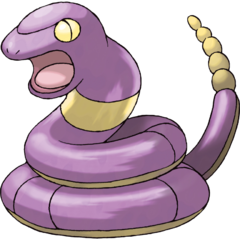

Effectively purple snakes, Ekans resembles a rattlesnake while Arbok is a cobra. A pure Poison-type with a fierce reputation, the first version exclusive monsters in National Dex order, only widely available in the Red version, while Green, Blue, and Yellow players had to trade for it. This often carries over to later games, where it's still found in only one version or another. Arbok is said to have different-patterned hoods depending on where they are found geographically. While this means that hood patterns vary in different depictions, there's only one pattern in-game.
- Balance Buff: Generation VII buffed Arbok's Attack to 95, though it's still rather unimpressive when compared to other physical attackers.
- Combat Pragmatist: Arbok is not above dirty-fighting, learning the Dark-type Payback, Beat Up, Sucker Punch, Throat Chop and Pursuit.
- Com Mons: In Red, Ekans is found on a wide variety of early routes.
- Confusion Fu: Can learn a variety of moves, between them Ground-, Rock-, Dark-, and Ice-type moves, in addition to the usual Poison-, and Normal-type learnset.
- Crutch Character: Ekans is catchable fairly early in Red, and evolves into Arbok at level 22, at which point it'll be much stronger than most enemy Pokémon. However, Arbok is still weak by fully-evolved Pokémon standards, and its Poison type does it no favors in a generation dominated by Psychic-types.
- Death Glare: It can learn Glare and Leer, which respectively paralyze the target and lower their defense.
- Dishing Out Dirt: Learns Earthquake, Rock Slide and Fissure.
- The Dreaded: One of their standard abilities is Intimidate, which lowers the Attack of all Pokémon on the other side of the field. It also has the Unnerve ability that prevents the opponent from consuming their held berry.
- Fire, Ice, Lightning: Arbok knows the three elemental fang moves naturally, though you need the Move Relearner to make use of them.
- Foil: To the Sandshrew line, in the Kanto and Johto games. They are the Poison-type serpent predator version exclusive counterpart to the Ground-type rodent prey Sandshrew.
- Gameplay and Story Segregation: Arbok is supposed to have different patterns on their hoods depending on which region they are caught in. However, only the Johto and Hoenn games have had Arbok with a different pattern than in other regions (this does not happen in the remakes). Furthermore, all Arbok have the same sprite or model in each game, even traded ones, so pattern differences are never present.
- Glass Cannon: Arbok's best stat is an Attack of 95. Its Speed and Special Defense are a subpar 80 and 79, respectively, and everything else is even worse.
- Lightning Glare: Its Secret Art, Glare, inflicts paralysis that's commonly represented to the player through sparks.
- Man Bites Man: Learns several biting attacks. In addition to the usual Bite and Crunch, Arbok can use the three elemental fangs, and it can be bred to have Poison Fang.
- Master of None: None of their stats are very good, with Arbok's highest stat being a below-average 85 Attack. It was later buffed to 95 Attack to make it more of a Glass Cannon.
- Mix-and-Match Critters: Ekans' design seems to have been based on the combined traits from several different snake species. Its lack of teeth and diet of eggs reference egg-eating snakes, while its venom and tail are inspired by rattlesnakes. Arbok's design is more uniformly based on a cobra, but its coiling behavior is reminiscent of non-venomous constrictor snakes like pythons and boas.
- Poisonous Person: Both of them are Poison-types.
- Sdrawkcab Name: Ekans is snake backwards. Arbok is kobra backwards (and misspelled).
- Secret Art: Glare, but only in Generation I. It’s still primarily restricted to snake-like Pokémon.
- Snakes Are Sinister: The probable reason why roughly one third of Team Rocket's grunts have one.
- Status Buff: Can learn Coil, which boosts their Attack, Defense, and accuracy, and Stockpile.
- Status-Buff Dispel: Can learn Haze, which resets all stat boosts Pokémon on either side of the field have.
- Stock Animal Diet: Ekans' Pokédex entries state that it loves to prey on eggs from bird Pokémon, such as Pidgey and Spearow.
- Super Spit: Using Stockpile and Spit Up. They also learn moves such as Acid, Gastro Acid, and Acid Spray.
0172: Pichu (ピチュー pichuu)
0025: Pikachu (ピカチュウ pikachuu)
0026: Raichu (ライチュウ raichuu)
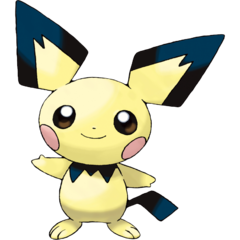

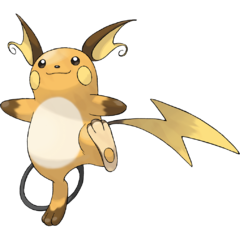
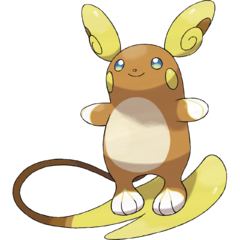
A yellow mouse-like creature with ruby-red cheeks, brown stripes on its back and a tail that resembles a thunderbolt, and the first Electric-type Pokémon in the Dex. As it is capable of being both cute and cool, it can appeal to both boys and girls, making it the perfect mascot for the entire franchise. Practically half of all merchandise has this guy's mug on it. It also gained a baby form in Pichu (which is also heavily promoted), and a few signature items and moves (mainly Volt Tackle). Raichu is its stronger form, but it isn't given as much exposure as its younger forms. Which isn't to say that it's bad per se; it's still a very good Pokémon to take well beyond the beginning of the game. It's one of your best bets when facing Misty.
Pikachu is one of the mainstay playable characters of Super Smash Bros., Nintendo's Massive Multiplayer Crossover Fighting Game series, while Pichu is a playable character in Super Smash Bros. Melee (the second entry) and returned in Super Smash Bros. Ultimate after a two-game absence. For tropes concerning their Smash incarnations, see the Super Smash Bros. 64 character page for Pikachu and the Super Smash Bros. Melee character page for Pichu.
The Alolan Raichu are unique from Raichu elsewhere in that they are Electric/Psychic-types and ride their tails as surfboards. How and why they've changed baffles researchers, but locals guess it's from eating too many pancakes.
Tropes that apply to the species in general
- Accessory-Wearing Cartoon Animal: Being the Series Mascot, it should come as no surprise that Pikachu tends to get advertised in an assortment of costumes. Detective Pikachu being the standout example.
- Adaptational Jerkass: This happens to Raichu on numerous occasions in the anime, due to them being rivals to Ash's Pikachu.
- Animal Stereotypes: Being mainly based on squirrels, it's no surprise that one of the Pikachu line's main gimmicks is storing something in their cheeks (in this case, electricity rather than food).
- Awesome, but Impractical:
- Pikachu became this from Gen II onwards when carrying a Light Ball; it hits like a truck and can one-shot a lot of things with the right coverage move, but it absolutely must be faster than its foe or else it'll get one-shotted itself.
- Their Secret Art Volt Tackle is this. You have to jump through a lot of hoops to get it, and when you do, it's a 120 power move with perfect accuracy and recoil just like Double-Edge. Problem is, their HP stat is so low that attempting to sweep with it will take Raichu down in a few turns.
- Pikachu with its Pikanium Z-Crystal is also this. Catastropika looks cool and is the second most-damaging Z-Move in the game, tied with Snorlax's Pulverizing Pancakenote (and in fact is the third most-damaging move in the game, period), but after one use, Pikachu is dead weight due to its overall low stats. The lack of a Light Ball means Catastropika only deals slightly more damage than a Light Ball Pikachu's Thunder, and less than a Volt Tackle, while only being able to be used once, making the Z-Move greatly unappealing.
- The Artifact: Despite the games gradually moving away from real-world locations and animals, Raichu's Pokédex entries still boast of its electricity being strong enough to knock out an Indian elephant. Pokémon Legends: Arceus retcons the "Indian elephant" into Copperajah.
- Badass Adorable: Pikachu may be cute and isn't fully evolved, but almost every form of canon has given it a way to stand up to the "big guys", including its evolved form. Raichu and its Alolan form is also this trope, but with more emphasis on the "badass" aspect (though both Raichu forms are still pretty cute). Gigantamax Pikachu is probably the most adorable kaiju you'd ever see along with Gigantamax Eevee.
- Balance Buff: Gen VI gave Pikachu a small boost in its defenses — 10 each, bringing it up to 40 and 50 — whereas Raichu got a small Speed increase — from 100 to 110.
- Blush Sticker: A rare example where it actually serves a functional purpose — the Pikachu line's Blush Stickers are actually special organs on their cheek pouches that store electricity to be released on command.
- Body Sled: Alolan Raichu uses its own tail as a surfboard, just like regular Raichu could do in the Stadium games if they had evolved from a Surfing Pikachu.
- Breakout Character: Pikachu was originally meant to play second fiddle to Clefairy. Then the anime chooses Pikachu as the Starter Mon for its main character, and Pikachu became the mascot of the franchise.
- Crutch Character: In RGBY (and their remakes), X & Y, and Sun & Moon, Pikachu (and Pichu in the latter case) can be found in the wild very early on. They'll likely be the first wild Electric-type a trainer will encounter, but will likely be outclassed by midgame. But if they have a Light Ball, then things are different (but not too much).
- Cute Little Fangs: Despite being rodents, the line has canine teeth (at least in the anime). This is likely to make them look cuter.
- Death or Glory Attack: They can learn Wild Charge and Volt Tackle, and both of these attacks cause recoil damage to the user. In particular, if Pikachu's holding a Light Ball, its Volt Tackle will deal immense damage... to both the foe, and itself.
- Depending on the Artist: Promotional artwork and Pokémon Generations depict Pikachu with a large oval-shaped head (similar to its pre-evolution Pichu), while the anime and games depict it with a smaller, narrower one.
- Disc-One Nuke: Wild Pikachu have a 5% chance to hold a Light Ball when caught, which doubles their Attack and Special Attack and effectively gives Pikachu base attacking stats slightly better than its evolution Raichu. While Pikachu is still fairly frail, it's fast enough for it to not be an issue for a while.
- Early Installment Character-Design Difference:
- Pikachu's original design was very chubby and it lacked a defined neck. As the series went on and it become more prominent as the Series Mascot, it became slimmer. In very early artwork, Pikachu was also depicted as having a white stomach and being significantly larger than it normally is. In Sword & Shield, Pikachu's Gigantamax form is a callback to its earlier, chubbier appearance.
- Once gender differences were established, female Pikachu went from having standard lightning-bolt shaped tails to having tails that vaguely resembled heart shapes. Female Raichu also have a slight nick on the tips of their tails.
- Early-Installment Weirdness: Despite being its Signature Move in all official media, Pikachu couldn't learn Thunderbolt naturally in Red and Blue, requiring the use of a TM. It would be able to learn Thunderbolt naturally from Yellow onwards.
- Electric Instant Gratification: Implied. The line's Hidden Ability, Lightning Rod, prevents them from being harmed if they are hit with an Electric-type move. Instead, it only boosts their Special Attack stat.
- Elemental Absorption: With Lightning Rod, not only is it immune to Electric moves, it gains a boost to its Special Attack.
- Fragile Speedster:
- Raichu is decently fast (especially after Gen VI gave it a permanent boost to its Speed), but is still frail. In Alolan Raichu's case, thanks to its Surge Surfer ability, its speed doubles in battle when Electric Terrain is active, and reaches levels so high it can outspeed Regieleki and Speed Forme Deoxys!
- Pichu in Super Smash Bros is cursed with the disadvantage of accruing damage if it attacks, but it's very good at evading enemy attacks. So long as you've got weapons turned on, it's possible to win any fight with just Pichu.
- Genius Sweet Tooth: It’s hypothesized in-universe that its diet plays a huge role in Pikachu developing into an Alolan Raichu, which might explain why the Alolan Raichu is part Psychic-type.
- Glass Cannon:
- Light Ball gives Pikachu offensive stats comparable with Olympus Mons. Unfortunately, even with a Light Ball Pikachu is still a not-fully-evolved Pokémon with the very low defensive stats that come with being one, rendering it still unable to compete in the big leagues.
- Alolan Raichu's Surge Surfer ability gives it an effective 220 speed while under the effects of Electric Terrain. If given time to use Nasty Plot, Raichu demolishes anything that isn't specially defensive given its great coverage moves in Psychic and Surf. But priority moves like Quick Attack are its counter, as Raichu's defenses are still nothing to write home about.
- Grievous Harm with a Body: A Cramorant at half health or less will scoop up a Pikachu while diving or surfing, and then spit it out at its opponent when hit, paralyzing the opponent.
- Iconic Item: The Light Ball item for Pikachu. It doubles Pikachu's Attack and Special Attack while being held, giving it about as much power as Rayquaza.
- Informed Flaw: Pichu are said to be unable to handle their electricity, often shocking themselves. In the main games, this isn't the case unless they use Wild Charge or Volt Tackle. It's a different story in Super Smash Bros., where over half of Pichu's attacks involve electricity and cause damage to itself.
- Kid-Appeal Character: Pichu and Pikachu were basically designed to be this. Surprisingly, this is intentionally averted for the more adult-like Pikachu from Detective Pikachu, who has spoken (human language) lines akin to a stereotypical hard-boiled detective, complete with a deep voice (most famously provided by Ryan Reynolds in the movie) that's a far cry from the child-like voice provided by Ikue Otani.
- Late Character Syndrome:
- Pikachu typically is found either early on or halfway through each mainline game. In the Gen II games and their remakes, however, Pikachu can only be found in the post-game Kanto region (route 2 for the former generation and Viridian Forest for the latter). By then, you probably won't have much use for it, especially considering its extremely low level. Crystal allows players to get a little earlier by making it purchasable at Celadon Game Corner, however. The Odd Egg given for free at the daycare center in Crystal can also hatch into a Pichu if the player is lucky.
- In the Gen V games, Pikachu (and its evolutions) must be transferred from older games in order to be obtained, despite several other, lesser-known older Pokémon appearing in the other postgame areas.
- Lethal Joke Character: Pikachu, even with its later stat and moveset buffs, is a pretty standard frail pre-evolution. Giving one a Light Ball, however, doubles its Attack and Special Attack, which, combined with its ability to learn nearly every top Electric attack, can make it devastating in a quick pinch.
- Magic Knight:
- Raichu's Attack and Special Attack are equally decent, both at 90. Alolan Raichu is only slightly less so, trading 5 points in Attack for an equal boost in Sp. Attack. Not that it's much of a problem, though, considering most Electric- and Psychic-type moves are classified as Special.
- With the Light Ball, Pikachu becomes this, as Light Ball doubles its current Attack and Special Attack stat.
- Mascot Mook: Definitely counts as this if you consider its role in the main games alone.
- Mascot with Attitude: Pikachu tends to be an Adaptational Badass and a Tsundere in adaptations, most notably pronounced in Pokkén Tournament. Its initial appearance in the anime prior to Character Development also had a snide disposition and Detective Pikachu puts on a tough front.
- Mutually Exclusive Power-Ups:
- Pikachu has more event-exclusive moves than any other Mon, but they aren't compatible with each other or Volt Tackle.
- Most Pokémon of the same species are able to pass Egg Moves to each other if placed in the Day Care in Gen VIII, so long as the student has an empty move slot. However, Gigantamax Pikachu can't learn Volt Tackle when placed with one of its own offspring that does.
- Mythology Gag:
- Alolan Raichu surfing on its tail is a reference to the Surfing Pikachu from Pokémon Stadium, which had blue eyes and, if evolved into a Raichu, would stand on its tail when using Surf.
- Gigantamax Pikachu heavily resembles Pikachu's original design.
- Occult Blue Eyes: Alolan Raichu has distinct blue eyes and is part Psychic-type.
- Our Fairies Are Different: While not officially Fairy-type Pokémon (not to mention that the only offensive Fairy-type move they can learn is Disarming Voice, and that is only learned via breeding), Pikachu and Raichu have been part of the "Fairy" egg group since the mechanic was first introduced. Two Pokémon based on the line, Dedenne and Mimikyu, are part Fairy-type.
- Out of Focus:
- Raichu, in comparison to Pikachu and even Pichu. Game Freak seems to be adamant on making sure you forget that Pikachu can still evolve and Niantic will go out of their way to make any special-event Pikachu unable to evolve. However, this trope was finally subverted as it did get an Alolan Form in Generation VII and an unique Z-Move on top of it. The Let's Go games restore the status quo by introducing a lot of buffs to 'Partner Pikachu' who, like Ash's Pikachu and Red's Pikachu in Yellow, won't evolve, and further unlocks a Gigantamax Pikachu in Gen VIII which also can't evolve (which means that Pikachu is screwed over given that it has terrible stats and can't evolve to fix that). This also happened in Pokémon Unite (where Pikachu is the only middle-stage Pokémon that doesn't evolve), and Pokémon Masters (where the protagonist also has a Pikachu that doesn't evolve (and is also really weak, not being able to be 6 Star EX'd) and Lt. Surge originally eschewed his signature Raichu for an Electrode).
- This even gets acknowledged in Raichu's Ultra Moon Kantonian Pokédex entry:"Because so many Trainers like the way Pikachu looks, you don't see this Pokémon very often."
- Permanently Missable Content:
- A zigzagged example regarding Surfing and Flying Pikachu. There have been frequent ways to obtain Pikachu with these moves throughout the history of the series. However, the cruel twist is that they cannot be transferred to the next generation of games due to Pokémon with HM moves not being transferable unless the move is forgotten. Thus you can transfer these special Pikachu, but you need to remove what makes them so special in the first place. The few ways to obtain these Pikachu have either long since passed or the games you can get them are out of print. Sword and Shield's introductions of TRs changes this in regards to Surf, as all Pikachu can learn the move now through TR04, though Flying Pikachu is still this.
- Notch-ear Pichu also counts as an example, as the only way to obtain one is through an event that has also long since passed, and it also can't be transferred to later games, as the code for it doesn't exist in the files.
- Pokémon Speak:
- Pikachu is featured in the trope image. Notable because it's the only Pokémon to have its actual spoken name as an audio cry in the main series games in Yellow (or at least it was until Let's Go Pikachu & Let's Go Eevee and Sword and Shield, which gave Eevee the same treatment). Pikachu's cry is also changed to have such speech from X and Y to Brilliant Diamond and Shining Pearl, where the latter gave the option to switch between that and the original cry. Legends: Arceus onward brings it back to its original cry.
- NPC Pikachu in the games do this through their speech bubbles.
- Popularity Power: Zigzagged in the anime, where Ash's Pikachu frequently fluctuates in power level to reflect Ash's own fluctuating experience level at that point. Harshly averted in the games where, for all of being the Series Mascot, Pikachu is one of the weakest Pokémon in the series, even with all its exclusive moves and items whereas Raichu is far more powerful, even more so after Pokémon Sword and Shield gave it the ability to learn Quick Attack and Agility after evolving.
- Power Floats: Alolan Raichu surf on their tails in mid-air. Even in Pokémon Refresh and Pokémon Camp, they never touch the ground, merely sitting on their tails to rest.
- Power Glows: Raichu glows faintly in the dark, as a result of the weak electrical charge it constantly exudes from its body.
- Power Incontinence:
- Pichu shocks itself because of youth and inexperience. This carries over into Super Smash Bros. Melee, where it cripples it so much that it's the weakest character in the game. When Pichu returns in Super Smash Bros. Ultimate, it still retains this feature, but hits much harder than Pikachu to compensate, making it more akin to a traditional glass cannon.
- Raichu is repeatedly stated in the Pokédex to become more aggressive the more electricity it builds up to the point that some theorize that it is causing Raichu stress. Raichu seems to also not have full control over its powers, as Raichu plants its tail to the ground to prevent itself from getting hurt by its own high-voltage electricity, especially since the ground the tail is on is noted to become scorched like it was struck by lightning.
- Power Up Letdown:
- For the longest time, the games shrewdly discouraged players from evolving Pikachu due to its Wolverine Publicity, with Raichu getting almost no buffs and its moveset remaining bare, while Pikachu's got raised to make it halfway competitive (though not by much). Gen VI onwards, the series has been gradually kinder to Raichu, with a small Speed buff, a full moveset, and a dual Psychic type Alolan form. Even beforehand, this trope only went so far, as a Raichu evolved after learning Pikachu's full moveset was still significantly sturdier, especially if you didn't have a Light Ball, not to mention Raichu can take more advantage of Dynamaxing and Terestal than Pikachu can.
- Gigantamax Pikachu much like Gigantamax Eevee falls into this as its only benefits are a higher HP bar and the ability to paralyze Ground-types with G-Max Volt Crash with the latter only working in Double and Max Raid Battles. Other than those two, it still has terrible stats and can't evolve whereas Dynamaxed Raichu has more bulk and can scare off Ground-types with Max Geyser (Surf) and Max Overgrowth (Grass Knot).
- Pretender Diss: Alolan Raichu's Ultra Sun Pokédex entry says that another name for this Pokémon is "Hodad", Hawaiian slang for a poser, or someone who hangs around the beach and acts like a surfer, but never surfs.
- Progressively Prettier: Pikachu's design started out fairly pudgy, but became much slimmer and sleeker over time.
- Psychic Powers: Alolan Raichu is part Psychic-type.
- Psycho Electro: Not normally, but Raichu gets aggressive if it stores up too much electricity in its body, due to the physical stress of doing so.
- Recurring Element: There is at least one Electric Rodent "Pikaclone" in every Generation except Generation II, when Pichu was introduced.
- Riddle for the Ages: How Alolan Raichu gained the Psychic type is unknown, but it's speculated that it gained it from eating too many pancakes.
- Ridiculously Cute Critter: THE... WHOLE... FREAKING... LINE!! Pikachu's adorable, simplistic design is one reason it's so widely beloved. Pichu is an already cute Pokémon, made even more marketable. Even Raichu has not lost everything here, and its Alolan form is even rounder and cuddlier.
- The Rival:
- Meowth to Pikachu in the anime specifically, largely due to the heroes keeping a Pikachu out of its ball and the villains keeping a Meowth in the anime. They are a literal Cat-and-Mouse duo, with the antagonistic cat doing the chasing with a lot of zany schemes and contraptions, only to be outdone by the heroic mouse doing what comes naturally to survive (in this case shooting electricity). Incidentally, their National Dex numbers, 25 and 52, are inversions of each other, and both lines receive Alolan forms in Gen VII (though it’s only for the final form in the Pikachu line’s case). Later they would both have their Gigantamax forms revealed together (along with Eevee, see below)
- Raichu also often plays this role towards Pikachu, especially in the anime.
- Eevee is also a counterpart to Pikachu since they were used by Gary and Ash respectively in their first battle in the anime. Eevee has since shared an 'honorary' starter status like Pikachu as the rival's starter in Yellow Version, and a starter in certain spinoffs. In the lead up to Sun and Moon, they also got their Z moves revealed together in a trailer
 focusing on version exclusives (typically also pitted as counterparts). Both Pokémon received equal billing for Pokémon Let's Go, Pikachu! and Let's Go, Eevee!, where you can start out with either one depending on the version, which also gives you an Old Save Bonus to unlock their respective Gigantamax forms in Sword and Shield.
focusing on version exclusives (typically also pitted as counterparts). Both Pokémon received equal billing for Pokémon Let's Go, Pikachu! and Let's Go, Eevee!, where you can start out with either one depending on the version, which also gives you an Old Save Bonus to unlock their respective Gigantamax forms in Sword and Shield.
- Secondary Sexual Characteristics: Female Pikachu have heart-shaped tails, and regular female Raichu's lightning-bolt tail ends are slightly blunted. Averted with Alolan Raichu and Gigantamax Pikachu, thoughnote .
- Secret Art: As the Series Mascot, the Pikachu line has more moves of this type than any other family as of Pokémon Sun and Moon:
- Volt Tackle from Generation III onwards, a severely damaging physical move which deals recoil damage and might Paralyze the target. You can only get it by breeding a Pikachu/Raichu holding a Light Ball or from a Move Tutor in Sun and Moon.
- Along with the other Pikaclones, it's one of the few Pokémon that can learn Nuzzle.
- When holding its special Z-Crystal, Alolan Raichu can use Stoked Sparksurfer. Pikachu also has its own unique Z-Move, Catastropika, which has a unique Z-Crystal and is derived from Volt Tackle, dealing even more damage with no recoil.
- There is also Cap-wearing Pikachu with its own Z-Move that turns Thunderboltnote into 100,000,000 Volt Thunder Bolt, which deals massive damage while having a heightened crit rate.
- Alolan Raichu is the only Pokémon that has Surge Surfer as an ability, doubling its speed in Electric Terrain.
- Series Mascot: Pikachu usurped Clefairy's intended role due to better reception.
- Shock and Awe: The Pikachu line and their imitators are all Electric-type. Alolan Raichu is part Psychic-type, which adds an extra layer of awe.
- Shout-Out: Volt Tackle was based on Pulseman'snote Voltteccer attack, which in turn was based on Tekkaman.
- Signature Move:
- Even though they have a boatload of exclusive moves, the line is still most heavily associated with Thunderbolt thanks to the anime.
- Iron Tail is also closeley associated with the species due to the anime, to a point where it gains natural access to the move in Legends Arceus.
- Squishy Wizard: Raichu have ok attacking stats, Speed and Special defense, but a low HP and even lower Defense means they will fall to any powerful physical hit.
- Starter Mon: Pikachu is the only starter available in Pokémon Yellow, a special version which is based on the anime. Pikachu reprises their role as a starter in Pokémon Let's Go, Pikachu! and Let's Go, Eevee!
- Status Infliction Attack: The line's Static Ability can inflict paralysis on opponents that physically strike them.
- Stuck in Their Shadow: In-Universe. The Ultra Moon Pokédex entry for Raichu states that it isn't found often because many trainers prefer Pikachu's appearance over Raichu's.
- Super Mode: Certain Pikachu are capable of Gigantamaxing. It ends up resembling the pudgy designs from early on in the franchise and can use G-Max Volt Crash.
- Super-Speed: Can learn Agility. Alolan Raichu also has the ability Surge Surfer, which doubles its speed in electric terrain.
- Support Party Member: Surprisingly versatile in this department, as the line learns Helping Hand, Encore, the Light Screen and Reflect duo and Follow Me. It even gets Wish, though after Gen V it doesn't really do much.
- Surfer Dude: Alolan Raichu not only ride their tails like surfboards, but their coloring makes them appear to be tanned as well. Despite this, the people of Alola don't see them as such, considering them posers.
- Status Buff: The line learns Agility, Defense Curl and Nasty Plot. Alolan Raichu gets Calm Mind too.
- Throw the Dog a Bone:
- After 20 years of neglect in favor of featuring its previous evolutionary states, Raichu finally gains a new form in the Alola Region. This form has a unique Z-move to boot.
- Furthered in Gen VIII, where even Kanto Raichu finally gets its own evolution exclusive attack, Thunder Punch. It is also finally able to relearn all of its pre-evolutions' attacks, no longer leaving Raichu screwed if it's evolved prematurely. Then, Dynamaxing and Terestal in VIII and IX leave Pikachu stuck with terrible stats (and Gigantamax Pikachu can't even evolve!) whereas Raichu has enough bulk to use these effectively and can chase off Ground-types with Surf and Grass Knot.
- In the TCG, most Pikachu cards, save for special ones like the EX cards are incredibly weak in terms of health and damage power whereas Raichu cards are very powerful and it even got a BREAK card.
- Trademark Favorite Food:
- At least for Ash's Pikachu in the anime, it is ketchup. This originated in a mid-Kanto episode (with a couple of sporadic reminders in later episodes), and immediately reached memetic levels. In the earliest years, the family was associated with apples.
- Alolan Raichu are apparently fond of fluffy pancakes and other sweets, and the people of Alola joke that they might be the cause for their Psychic typing and floating.
- Underground Monkey: Alolan Raichu are unique from Raichu from elsewhere by being part Psychic.
- Unstable Powered Child: As the least evolved in the line and thus the "baby", Pichu has some trouble controlling the electricity running in its body, and as a result shocks itself when surprised.
- Useless Useful Spell: Wish is this in later gens, as it was changed to heal based on the user's HP stat. With a low HP of 60, Raichu's Wishes are fairly unimpressive.
- A Wizard Did It: Nobody knows why Raichu has a different form in Alola. The people there guess that they "ate too many sweet and fluffy round pancakes".
- Wolverine Publicity: As a result of its main character status in the anime, Pikachu was used excessively even in promotional media and art exclusive to the games or trading cards, as well as usually representing the franchise in cross overs such as Super Smash Bros.. This also began to happen in the games after Pikachu's absence in Generation V; X and Y gave Pikachu its anime cry in the games proper, Omega Ruby and Alpha Sapphire introduced Cosplay Pikachu, and Sun and Moon gave the line three exclusive Z-Moves, introduced a doppelgänger in the form of Mimikyu, and gave Pikachu an event-exclusive form with Ash's various caps. Sword and Shield would have newcomer Cramorant gain the ability to pick up Pikachus.
Tropes that apply only to a particular kind found in the games
- Adaptational Badass: It's one of the strongest 'mons in Pokémon Unite, even more so than most that would easily outclass it in the mainline games. Some people even call Pikachu "overpowered" in Unite. As the gaming site Game8 notes, "Pikachu is a powerhouse in all stages of the game due to its high damage output and stun capabilities. Its Unite Move's fast charge rate means that Pikachu can consistently get a surge in power whenever it needs to."
- Action Fashionista: Cosplay Pikachu. She has five different costumes that she can wear in battle, and can use specific moves depending on what she's wearing.
- Balance Buff: To make up for its inability to evolve, your starter Pikachu in Let's Go, Pikachu! gets a huge exclusive 110 buff, with more decent attack stats, slightly less frail defences, and unbelievable speed. Other Pikachu remain the same however.
- Baritone of Strength: The titular Detective Pikachu has an impressively deep, gruff voice as befitting of a hardboiled detective like him.
- Boss Battle:
- Breakout Character: Of all the costumes available, Pikachu Libre quickly became a fan-favorite and would go on to appear in several games after her debut, such as being a completely separate character from the standard Pikachu in Pokkén Tournament, becoming one of Pikachu's alternate costumes in Super Smash Bros. Ultimate and a prize in Pokémon GO.
- Clothes Make the Superman: Cosplay Pikachu gets a new move for each of its costumes in Omega Ruby and Alpha Sapphire. Rock Star gets Meteor Mash, PhD gets Electric Terrain, Pop Star gets Draining Kiss, Belle gets Icicle Crash, and Libre gets Flying Press.
- Contractual Purity: An in-universe example has been implied to be the case with Cosplay Pikachu, as she is unable to breed. The various Cap Pikachu introduced in Sun and Moon are similarly unable to breed.
- Cosplay Otaku Girl: A female Pikachu given as a gift in Omega Ruby and Alpha Sapphire has the ability to wear costumes based on the five contest conditions. Like Rotom, she also gains a new move for each costume she's currently wearing.
- Costume Porn: Cosplay Pikachu can wear several outfits in the Ruby/Sapphire remakes.
- Crutch Character: The Cosplay Pikachu from Omega Ruby and Alpha Sapphire. When the player gets her, she'll be at Level 20, likely higher than the player's party if you get her as soon as possible, and she comes equipped with unique moves that have mid- to endgame levels of power. However, as the player progresses, the fact that Pikachu's stats are below mediocre in every single stat other than Speed, plus being barred from evolving, means that she will quickly be outclassed and be little more than a novelty. Can be subverted if the player finds the Light Ball lying around on Route 120 or snags one off a normal wild Pikachu from the Safari Zone, which will make her hit about as hard as Rayquaza while holding it.
- Depending on the Writer: In the anime, Cosplay Pikachu is five Pikachu each wearing one costume, though Rock Star and Libre are male. This is repeated in the manga where this time, only Pop Star is female and again in Pokémon: Hoopa and the Clash of Ages, all five of the Pikachu are female.
- Hardboiled Detective: The eponymous character of Detective Pikachu.
- Interspecies Romance: The Pikachu in Pokemon: Yellow Version quickly develops a crush on a Clefairy that he meets at a gathering in Vermillion City.
- Making a Splash: Other than the non-offensive Rain Dance, Pikachu can use Surf in every generation, one way or another, but not through the HM. In most cases, it's an event Pikachu that already know the move by the time you got it. Unfortunately, because HM moves need to be forgotten in order to move a Pokémon to a later generation of games, this means that Surf would need to be removed from the Pikachu and it can't be relearned. Gen VIII finally universalizes the ability to use Surf via TR to all Pikachu.
- Masked Luchador: Cosplay Pikachu as Pikachu Libre.
- Not Quite Flight: You can obtain a Pikachu that knows the move Fly from a Pokéwalker course. According to the card game, it flies via Balloonacy.
- Not Allowed to Grow Up: The Pikachu starter in Pokémon Yellow (unless traded to other versions), Spikey-Ear Pichu, Cosplay Pikachu and Cap wearing Pikachu will not evolve and furthermore Cosplay Pikachu and Cap wearing Pikachu are unable to breed. Likewise, Partner Pikachu is locked out of evolution and breeding, but has higher base stats to compensate. Pikachu who have the ability to Gigantamax cannot evolve either, seriously screwing it over.
- Pimped-Out Dress: Cosplay Pikachu as Pikachu Belle or Pikachu Pop Star.
- The Power of Rock: Pokémon Ranger: Guardian Signs had a special Pichu partner who plays a Ukulele. You have the option to let it play it and paralyze the opposing Pokémon. It's also invincible and can be used to stun Pokémon like Mewtwo and Arceus. Cosplay Pikachu in her Rock Star costume can use Meteor Mash in this form.
- Promotional Powerless Piece of Garbage:
- In HeartGold and SoulSilver, you can obtain a special Pichu with three spikes on one of its ears (Spiky-Eared Pichu). Too bad it can't evolve or be traded to any other game, not even Black and White, which came after these games.
- Special event Pikachus in Pokémon GO often can't be evolved unless the costume is very minimal (Pikachus in tiny hats are so far the only ones with a chance at evolving). And since Pikachu's maximum CP level averages at around 1000, it doesn't make for a useful combatant.
- Opaque Nerd Glasses: Cosplay Pikachu in her PhD costume.
- Secret Art:
- Partner Pikachu in Let's Go, Pikachu! has four of these (which cannot be learned by any other Pikachu). First is Zippy Zap, an Electric-type move which has a Priority of +2, going before any move that has a lower priority than Extreme Speed, and will always land a Critical Hit. Second is Floaty Fall, a Flying-type move that has a chance to make the target flinch, third is Splishy Splash, a Water-type move which has a chance to paralyze the target, and fourth is a Limit Break, Pika Papow, the power (and flashiness of the move's animation) increase as the player's friendship with Pikachu grows.
- Gigantamax Pikachu in Pokémon Sword and Shield have G-Max Volt Crash. The move replaces Gigantamax Pikachu's Electric-type moves, and, on top of damaging the target, inflicts paralysis on the opponent's active Pokémon. While the Gigantamax Form used to be exclusive to an event Pikachu acquired through an Old Save Bonus for Let's Go, Pikachu!, a Wild Area event that ran between May 11, 2020 and May 18, 2020 made Gigantamax Pikachu able to be fought and captured in Max Raid Battles, and through the Isle of Armor, any Pikachu can gain the ability to Gigantamax by consuming Max Soup.
- Surfer Dude: The ones who know Surf uses it by grabbing an actual surfboard.
- Talking Animal:
- The most distinguishing characteristic of Detective Pikachu's title character is his ability to actually talk.
- Ash's Pikachu is also able to in Pokémon: I Choose You!, though it could be a result of Ash's bad concussion.
- Time Travel: In HeartGold/SoulSilver, there's a Pichu with a spiky ear that you can recruit if you have a Pikachu-colored Pichu (an event Pokémon). This Pichu travels through time with Celebi, but is unable to evolve because of it.
- Uncatty Resemblance: The first/default costume of the Cosplay Pikachu depends on the character the player chose, and thus the costume he/she uses for Contests: Rock Star for Brendan, and Pop Star for May.
- Unique Enemy: While "enemy" is a bit of a stretch, Notch-Ear Pichu has a unique sprite compared to other Pichu and Cosplay Pikachu has a unique model design, implying that they're supposed to be one-of-a-kind. Although in Cosplay Pikachu's case, this is Averted as 3 Pikachu, all with Cosplay Pikachu's distinctive tail, appear in the anime.
- Vocal Dissonance: Detective Pikachu has a deep masculine voice. Incredibly strange coming from a one and a half foot tall rodent. The film splits the difference by having Ryan Reynolds do Detective Pikachu when talking to Tim and Ikue Otani for her regular Pokémon Speak to anyone else.
- Wholesome Crossdresser: Rock Star Pikachu and Pikachu Libre are both masculine-looking costumes, the former highly resembling Brendan's contest costume, but they can only be worn by Cosplay Pikachu, who's female. Averted in the anime, where two male Pikachu are the ones that wear those outfits and exaggerated in Pokémon Adventures where 4 of the 5 Cosplay Pikachu are male.
0027: Sandshrew / Sand (サンド sando)
0028: Sandslash / Sandpan (サンドパン sandopan)

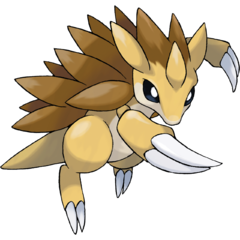
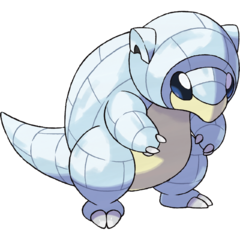

Sandshrew and Sandslash don't really resemble shrews as much as they do armadillos or pangolins. They're the creatures you'll find in place of Ekans and Arbok if you have the Blue or Green versions in the original set of games. As Ground types, they really don't like the wet stuff and prefer to make their homes in dry places, the drier the better. They get all their moisture from their food, just like many real desert animals.
In the Alola region, frequent volcanic eruptions drove Sandshrew and Sandslash away from desert environments and into the snowy mountains. There they adapted to life in cold environments and became Ice/Steel types. They developed inflexible shells of steel-hard ice and their claws have become adapted to digging through snow and gripping to icy surfaces.
- Achilles' Heel: The Alolan line will be put to the ground by Fighting- and Fire- type moves.
- Astonishingly Appropriate Appearance:
- The Ice/Steel Alolan Sandshrew has armor that resembles an igloo.
- Regular Sandshrew has a hide that resembles yellow bricks, which brings Egyptian pyramids to mind.
- Attack Its Weak Point: Sandshrew and their evolutions have soft underbellies, hence why they curl up into balls or in the case of the more inflexible Alolan variety grip hard to icy surfaces. Weavile in Alola hunt them by flipping them over before attacking their soft underbellies.
- Be the Ball: The line learns Defense Curl, which doubles the power of Rollout. They also learn Gyro Ball. The Alolan Sandshrew's icy shell prevents them from properly curling into a ball, but they're still capable of using Ice Ball (since that move involves the user encasing itself in a sphere of ice, without needing to curl into a ball itself).
- Taken to its logical conclusion with the curling rock-esque Alolan Sandshrew, which are used as exactly that during an Alolan festival.
- "Blind Idiot" Translation: Its classification of the "Mouse Pokemon" is an obvious mistranslation. In Japanese, Nezumi refers to rodents of any sort, implying Sandslash is meant to derive from porcupines and hedgehogs.
- Com Mons: In Blue, Sandshrew is found on a wide variety of early routes. Sandslash is stronger than the other Com Mons, though.
- Dishing Out Dirt: Most of the world's Sandshrew are Ground-type. Despite this, however, it took until Generation III for it to learn a damaging Ground attack via level-up, and even then, it was the very low-power Sand Tomb. Black 2 and White 2 finally remedied this, giving it access to Magnitude, Dig, and the mighty Earthquake through leveling up.
- Dump Stat: Alolan Sandshrew is tied with three other Pokémon for having the lowest Special Attack stat.
- Extra-ore-dinary: Alolan Sandshrew and Sandslash are part Steel-type. The latter's spikes are made of frozen-over steel.
- Flipping Helpless: Alolan Sandshrew are hunted by Weavile, which are smart enough to flip the former on their backs to get around their otherwise-formidable defense.
- Foil:
- They were originally counterparts to the Ekans line, appearing in Blue as the rodent prey with the supereffective typing against the serpent predator of Red.
- The Ice-type Alolan species are counterparts with the also Ice-type Vulpix line in Generation VII. Both of them are Version-Exclusive Content and Ice-type variants of a Kanto Pokémon, and both of them focus on Hail instead of another weather condition they were formerly associated with. Alolan Sandslash is a Mighty Glacier that uses physical attacks, while Alolan Ninetales is a Fragile Speedster that uses special attacks. Alolan Sandslash's hidden ability lets it speed up in Hail, while Alolan Ninetales's lets it set up Hail automatically, making the two great partners for each other.
- In Let's Go, Pikachu and Eevee, Ekans' and Arbok's role as the alt-version's predator is supplanted by Meowth and Persian, a fellow scratch attack-focused species but with Fragile Speedster stats contrasting the Sandshrew line's Mighty Glacier ones.
- Glacier Waif: Sandslash's Attack & Defense stats are higher than its small size would suggest. The latter is slightly better for Alolan Sandslash. Bonus points for being part Ice.
- An Ice Person: The Sandshrew and Sandslash of Alola are part Ice-types.
- Informed Flaw: Alolan Sandshrew and Sandslash are described as slower in pre-release material than most others of their species, but have the same Speed stat as their regular counterparts in the game itself.
- Kryptonite Is Everywhere: Alolan Sandshrew and Sandslash's Ice/Steel typing comes with double weaknesses to Fire and Fighting and a regular weakness to Ground, all of which are common attacking types. The Steel typing covers Ice's weaknesses to Rock and Steel, but offensive moves of those types are less common.
- Life Drain: Their Alolan forms can learn Leech Life via TM.
- Lightning Bruiser: Their Hidden Ability doubles their speed under Sandstorm for the regular forms, and in Hail for the Alolan forms.
- Magically Inept Fighter: The line has decent Attack, but horrible Special Attack. The Alolan forms pay for their slightly better Special Defense in exchange for among the lowest Special Attack stats of any Pokémon.
- Mascot: Both varieties of Sandshrew are the mascots of real world Japan's Tottori Prefecture.
- Mighty Glacier: Sandslash is slow, but it has high Defense and good Attack. Their Alolan counterparts are even slower (in-universe, anyway) and heavier, but have better defenses. And are half Ice type, to boot.
- Non-Indicative Name: The line are more like pangolins than shrews, though this is only a problem in the English releases. The Alola region forms make even less sense, as they've adapted away from living in the desert or near any sand, meaning even their Japanese names don't fit.
- Picky Eater: Sandshrew seems to not like foods with a high water content.
- Ridiculously Cute Critter: Sandshrew. The Alola version is even rounder and cuter.
- Rolling Attack: Rollout and Ice Ball, which deal more damage the more turns in a row they hit.
- Shown Their Work: While desert dwellers, like real pangolins Sandslash are pretty good at climbing trees.
- Spikes of Doom: Sandslash has a lot of spikes on its back, just like actual pangolins. This is also presumably how they use Poison Sting. The frozen-over steel spikes of the Alolan form are even gnarlier, and can cause deep wounds and frostbite. It's also able to learn Spikes in Sword and Shield.
- Spin Attack: Learns Rapid Spin. Instead of rolling into a ball, Alolan Sandshrew spin like curling rocks.
- Status Buff: Is able to buff all its stats with Work-Up, Hone Claws, Swords Dance, Amnesia, Agility and Defense Curl.
- Trap Master: Has been able to learn Stealth Rock since its debut in Gen IV, and was given Spikes in Gen VIII. It is also able to learn Rapid Spin to remove those hazards.
- Underground Monkey: Living in snowy wastelands instead of sandy deserts, the Alolan Sandshrew have evolved an icy shell and evolve into Sandslash with ice-covered steel spines.
- Weak Against Magic: Despite their high Defense, Sandslash has below-average Special Defense, with Alolan Sandslash having only slightly better Special Defense than its Kantonian counterpart.
- Weak Sauce Weakness: Fire-type moves will easily melt the Alolan line - karate chops from Fighting-types will be similarly effective.
- Wolverine Claws: Sandslash owe their English names to the big claws that they have on their front limbs. This is also shown when they learn Crush Claw after evolving. The Alolan Sandslash have claws that are hooked, to provide better traction on slippery ice.
- You Have Researched Breathing: Despite being Ground-types said to burrow in dry deserty places, before Gen III Sandshrew and Sandslash could not learn offensive Ground-based attacks by level up, and before Pokémon Black 2 and White 2 they could only learn Ground moves like Dig, Magnitude, and Earthquake from TMs.
0029: Nidoran♀ (ニドラン♀ nidoran mesu)
0030: Nidorina (ニドリーナ nidoriina)
0031: Nidoqueen (ニドクイン nidokuin)
0032: Nidoran♂ (ニドラン♂ nidoran osu)
0033: Nidorino (ニドリーノ nidoriino)
0034: Nidoking (ニドキング nidokingu)

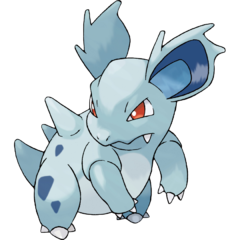


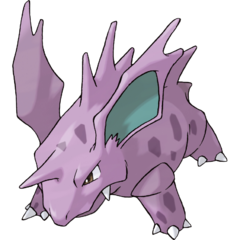

One of the most notable things about these guys is that the males and females are different species. This is because the first generation of games (Red/Green/Blue/Yellow) didn't assign sexes for Pokémon yet. They vaguely resemble rabbits at first, but they grow to be reptilian upon evolution. Both Nidoqueen and Nidoking are very dependable Pokémon. Nidoqueen is more defensive while Nidoking is more offensive, but both are extremely well-rounded. The first two stages of each gender are pure Poison type, while the third stage of each are both Poison/Ground type.
- The Artifact:
- Their uniqueness in being differentiated by gender has steadily become less and less significant, and they now seem out of place for it. Functionally, the two families could be combined into one at the base Nidoran level and made a single species with a movepool and evolutions that changes depending on its gender, because plenty of other Pokémon do just that now, such as the Burmy line, Meowstic, and Indeedee. But it would create a lot of headaches for the Pokédex organization and trading between generations, so that's not likely to happen.
- Nidorina and Nidoqueen's inability to breed from Gold and Silver onwards was first introduced in a Japan-only guidebook containing a lot of information that was later retconned, but said inability to breed still remains.
- Both Nidoran lines have abysmal level-up lists, filled with pitifully weak, mostly Normal-type moves. Neither learns anything stronger than a 65 BP move until level 50 at least. When they were first introduced in Gen 1, this was par for the course for many Pokémon. As time went on and the series' design was refined, nearly all their Gen 1 contemporaries had their level-up moves overhauled to make them more competitive or to integrate their in-game lore. Meanwhile, the Nidoran families stayed faithful to their terribly weak move lists for no apparent reason. Later Gen games would grant Nidoking and Nidoqueen Megahorn and Superpower upon evolution, respectively, but this doesn't make the rest of their natural moves any less archaic.
- Balance Buff: Gen VI provided both with a ten-point increase to Attack, bumping Nidoking to 102 and Nidoqueen to 92, further increasing their physical power.
- Bunnies for Cuteness: Nidoran of both gender resemble cute, if deadly poisonous and slightly mean-tempered, little rabbits.
- Cartoon Creature: They're poisonous porcupine-rabbit creatures that evolve into earth-elemental dinosaurs with aspects of rhinoceroses and gorillas. They also happen to resemble Baragon. If you choose to get technical, however, we can at least be confident that they are mammalian in origin, due to having external ears.
- Confusion Fu: Poison, Ground, Fire, Fighting, Water, Bug, Ice, Electric, Rock, and Dragon moves are all included in their movepool. There is nothing they cannot hit for at least neutral damage, and they have the bulk to put some force behind it, be it a Physical or Special attack. This is heavily encouraged by design: their natural level up moves are terrible, but they have fantastic TM access and an ability that benefits strong moves with effects.
- Crutch Character: Downplayed, as this was the intention, but in practice they come off more as a Disc-One Nuke. In-game, the Nidoran family's purpose is to add balance to your team by fitting multiple roles. They have a very wide movepool, but no outstanding stats. The developers even intentionally revised their movesets in Pokémon Yellow specifically because of this, giving them earlier access to the Fighting-type move Double Kick so they (alongside Mankey) can help the player overcome the massive type disadvantage they face against Brock's Rock-type gym.
- Disc-One Nuke:
- In the games set in Kanto or Johto, you can find a Nidoran and evolve it into Nidoqueen or Nidoking before you challenge the third gym, and in both regions the Leader will be at a major disadvantage (they're immune to Surge's Electric-types and resist Miltank's Rollout. Nidoqueen in particular isn't affected by Miltank's Attract). It will continue to pull its weight, but later on, its mediocre stats and noteworthy weaknesses to Water and Psychic will really start to hurt. That said, while they aren't as overpowered later on as they are early in the game, Nidoking and Nidoqueen are still perfectly capable of hanging in your party until the end of the game.
- It is also a major one in Pokémon Black and White. If you have access to the Dream World, you could get a Nidoran of either gender with its Hidden Ability (Hustle). However, since the Pokémon of Generation V tend to evolve far later than earlier Pokémon, this means that earlier Pokémon level up way earlier, with both Nidorans evolving at level 16 and then having the option to evolve them further with a Moon Stone. This means you can get a third stage Pokémon with a wide movepool and an extremely effective ability (Sheer Force) before your starters have evolved. Astonishing.
- With a bit of luck, it's possible to obtain a Nidoran (of either sex) with its Hidden Ability shortly after the second gym in Pokémon X and Y and obtain a Moon Stone to evolve it in the cave immediately afterwards.
- Dishing Out Dirt: Nidoking and Nidoqueen gain the Ground-type upon evolution.
- Gameplay and Story Integration: Female Nidoran being the only one in its evolutionary family able to breed in Generation II onwards references a passage from the 1996 "Pocket Monsters Encyclopedia" (released before Generation II) which states female Nidoran lose the ability to produce eggs when they evolve. However, the obscurity of this information also crosses into All There in the Manual territory.
- Hair-Trigger Temper: Most of Nidorino's Pokédex entries state that it is an aggressive Pokémon that is quick to attack with its horn.
- Jack of All Stats: Originally designed as this, with balanced stats and a massive movepool, they fell into Master of None as power creep caught on, and their offensive stats became merely above average. The addition of Sheer Force brought them back into the fold, though Nidoking's Defense and Nidoqueen's Speed remain their biggest downfalls.
- Loophole Abuse: Sheer Force removes the secondary effects of their moves, and the HP cost from a Life Orb is considered a secondary effect, so if they use a move that's affected by Sheer Force, they'll get the power boost from the Life Orb without losing any HP. They will lose HP if they use an attack that isn't affected by Sheer Force, though.
- Lunacy: The first in the National Dex to require the Moon Stone for evolution.
- Magic Knight: The introduction of Sheer Force boosts their offensive prowess on both sides from "halfway decent" to "actually pretty good", especially with their surprisingly diverse movepool.
- Male Might, Female Finesse: Downplayed. While Nidoking's stat spread is a bit more offensivenote , and Nidoqueen's a bit more defensivenote , both have the same massive movepool and can fullfill the role of a tanky wallbreaker very well.
- Mama Bear: Nidoqueen is said to be at her most powerful when she's protecting her young.
- Missing Secret: Likely responsible for a case of this in Generation II, as *female* Nidoran have had Charm as an Egg move since its debut in that generation, but male Nidoran never have. Bulbasaur and Snorlax, both of which share an egg group with Nidoran, and Oddish, which is part of Bulbasaur's other egg group, all have Charm listed among their egg moves in Gold and Silver, but no potential fathers that can learn it.
- Mix-and-Match Critters: Both Nidorans resemble little rabbits. Nidorino and Nidorina gain more lizard features. Nidoking and Nidoqueen are full-blown Rabbit/Dinosaur lizard creatures.
- Moon Rabbit: It can be hard to tell since they're more rabbit-porcupines than straight rabbits, but Nidoran are lagomorphs that achieve their final stage by exposure to the Moon Stone.
- Organic Bra: Nidoqueen has two noticeable chest plates.
- Palette Swap: Literally, in fact. The two genders' shiny forms switch colors with each othernote .
- Pint-Sized Powerhouse: Despite looking like hulking monsters and being fairly strong battlers, the two of them are only child-height when upright. Most depictions of them choose to ignore that detail.
- Pink Girl, Blue Boy: Inverted normally, played straight in their shiny versions, although Nidoqueen is mostly green.
- Poisonous Person: They're Poison-types.
- Purple Is Powerful: The male side is primarily purple, and is offense-based. In particular, they get Sheer Force, which greatly increases the power of moves with additional effects while removing said additional effects.
- Rhino Rampage: According to the Pokédex, once the rhino-like Nidoking starts his rampage, nothing can stop him.
- Rule of Cool: It makes sense for the Nidoran lines to evolve into their final stages using Moon Stones, being Moon Rabbits, but why hulking, Kaiju-esque monstrosities? Because it's badass.
- Shout-Out: Both Nidoking and Nidoqueen look like Baragon, a giant monster from the Godzilla films that is quite popular in Japan.
- Stout Strength: Nidoqueen has a thick, somewhat paunchy gut, and is just as powerful as the less chunky Nidoking.
- Unskilled, but Strong: With the ability Sheer Force, which increases the power of moves with additional effects at the cost of removing said effects.
- Unstoppable Rage: Nidoking goes on rampages that are impossible to control once they start, though a Nidoqueen he's known for a long time can calm him down.
- Your Size May Vary: One of the more egregious examples in the anime, where Nidoking and Nidoqueen are often portrayed as being huge, eight-foot-tall behemoths. While their strength is not understated, Nidoking's Pokédex entry lists its height as only 4'07" and Nidoqueen's as 4'03".
0173: Cleffa / Py (ピィ pii)
0035: Clefairy / Pippi (ピッピ pippi)
0036: Clefable / Pixy (ピクシー pikushii)
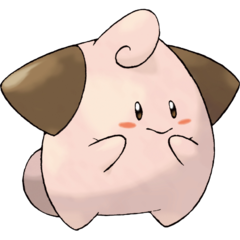
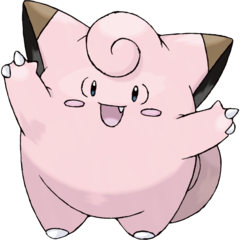
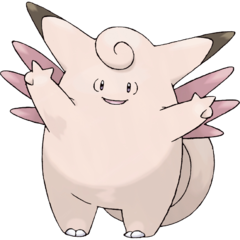
Pink cute Pokémon. Their stats don't seem remarkable, but they learn a fantastic number of moves, plus later games introduced an ability that prevents damage from anything other than direct attacks. Their Metronome technique makes them very unpredictable in battle. This family is thought to come from space, as they're found on mountains and other places with a history of meteor strikes behind them (like Mt. Moon, Mt. Coronet, Giant Chasm, Meteor Falls...). Originally a Normal type line, being switched to Fairy type in Gen VI.
- Achievements in Ignorance: Their Hidden Ability, Unaware, lets them ignore any stat boosts the opponent has (except Speed) by not knowing they're boosted.
- Balance Buff: Starting in Gen VI, the Clefairy line goes from being Normal-type to Fairy-type. Additionally, Clefable has its Special Attack increased by 10 points, allowing Clefable to hit harder than it previously did with its Special Moves.
- Blush Sticker: Cleffa and Clefairy. Clefable loses them, though.
- Confusion Fu:
- Like the Nidos, they have a massive movepool, and all-around decent stats that allow them to run both defense or offense with ease. Their main move, Metronome, also counts.
- Whether any Clefable you fight is a special attacker is in itself not a guarantee, as Clefable can also learn Belly Drum, which even with the line's mediocre Attack stat can turn any physical attack into a terrifying threat.
- Cosmic Motifs: They look like stars, are believed to come from space, and learn moves related to space such as Meteor Mash and Cosmic Power.
- Cute Little Fangs: Clefairy has a single fang in its mouth giving it some resemblance to cute kittens.
- Cuteness Proximity: One of their abilities, Cute Charm, will "infatuate" enemies of the opposite gender on contact, acting as a sort of paralysis. This includes any Pokémon of the opposite gender, though asexual Pokémon (including most Legendaries) are completely unaffected.
- Damn You, Muscle Memory!: Its typing retcon can lead to this when trying to fight it. Going from Normal to Fairy-type removed its immunity to Ghost, changed its Fighting weakness to a resistance, and gave it new resistances and weaknesses that it previously was neutral to.
- Disc-One Nuke: In Red, Blue, and Yellow, Clefairy can be caught as early as Mt. Moon, and evolved into Clefable with a Moon Stone found in the same dungeon, giving you a fully-evolved Pokémon with well-rounded stats and the ability to learn nearly every TM before the second gym.
- Epileptic Trees: In-universe; it's widely believed that they came from the moon.
- Heal Thyself: It can learn Moonlight and Life Dew as level-up moves, Wish as an egg move, and even Softboiled as a Fire Red and Leaf Green move tutor move.
- Innocent Aliens: They are shown to be rather peaceful, although according to the anime, they're kleptomaniacs.
- Jack of All Stats: With the exception of a low base 60 speed, all of Clefable's stats range from average to slightly below-average. Its abilities make up for it, though.
- Killer Rabbit: Not a lot of people will take Clefable seriously at first glance, but it has one of the single largest and most varied movepools in the entire history of Pokémon, and their Magic Guard ability lets them use Awesome, but Impractical moves like Double-Edge with absolute impunity, as well as making themselves immune to the damaging effects of everything barring direct attacks.
- Lunacy: They learn Moonlight and Moonblast, evolve with a Moon Stone, and are even said to come from the Moon.
- Mascot Mook: Clefairy was intended to be the mascot of the series, but due to Pikachu becoming a Breakout Character, it took the limelight instead. Clefairy does still show up quite a bit, especially as a mascot of Kanto and Sinnoh, but is less prominent than others. This gets a nod in Let's Go Pikachu and Let's Go Eevee by having Green use a Clefable in the same slot that Red uses his iconic Pikachu.
- Meaningful Name: They're fairy-like creatures whose English names include clef (referencing their clef note-shaped head curl) and some variant of "fae", while their Japanese names are based on "pixie" (especially the last on, Pixy). Quite fittingly, when the Fairy Type was introduced, they became pure Fairy, completely replacing their original Normal typing instead of becoming a dual-type.
- Megaton Punch: For some reason, the line gets Meteor Mash, which is otherwise exclusive to Metang and Metagross (it makes more sense in Japanese, where Meteor Mash directly translates as "Comet Punch").
- Mighty Glacier: The line has powerful defensive abilities in Magic Guard and Unaware that makes them more difficult to take down than their average stats suggest. On top of the useful supporting moves they can learn, they can also learn several powerful offensive moves that let them deal decent damage (especially after the Balance Buff in Gen VI that increased Clefable's Special Attack, making it its highest base stat alongside HP), especially as Magic Guard prevents them from taking indirect damage. They learn no moves that let them work around their low Speed outside of Thunder Wave, however.
- Moon Rabbit: Clefable's ears grow longer upon evolving with the Moon Stone from Clefairy.
- Nocturnal Mooks: Outside of caves, in Crystal and Sun and Moon, Cleffa and Clefairy can only be found at night.
- Non-Elemental: They're Normal-types prior to Gen VI - which is the reason for their ridiculous movepool even after they were retconned as Fairy-types.
- No-Sell: Magic Guard is an Ability that makes the Pokémon immune to anything that isn't a direct attack. This includes poisons, burns, sandstorms, hail, and even self-damaging attacks that they themselves use! Unaware is also a No-Sell in a different way; it completely ignores all stat boosts that the opponent has.
- Our Fairies Are Different: These have magic that let them use any move (albeit with no control over exactly which move gets used), and they're possibly from space. On top of that, the entire line has been revised in Generation VI to be a pure Fairy-type, not Normal/Fairy or even Fairy/Normal.
- Pink Is Feminine: They have a 75% chance of being female.
- Protection from the Elements: Their Magic Guard ability protects them from the residual damage of Sandstorm and Hail.
- Ridiculously Cute Critter: All of them are very cuddly-looking, especially Cleffa.
- Secret Art:
- In Generation I, it was the only Pokémon to learn Metronome by level-up, aside from Mew.
- It had a unique ability in Gen IV, being the only line with Magic Guard.
- Shrinking Violet: All of them are rarely seen, but Clefable is particularly reclusive.
- Status Buff: The line learns Amnesia, Calm Mind, Defense Curl and Work Up. They also learn the fairly rare Cosmic Power to boost both their defense stats, Minimize and Belly Drum for physical sets.
- Super-Senses: Clefable's hearing is said to be so sensitive that it can hear a pin drop from half a mile away, which is why they prefer to live deep in mountains where it's quiet.
- Third-Person Person: Clefairy talks like this in Pokémon Mystery Dungeon: Rescue Team.
- Weak, but Skilled: In a vacuum, Clefable's stats aren't really anything to write home about, but when paired with its solid typing, wide movepool, and incredible abilities, Clefable becomes a potent Mighty Glacier that can be extremely frustrating to bring down.
- Wings Do Nothing:
- Zigzagged. They have wings, but can't use them to fly and can only learn one Wing-associated attack. However, according to the Pokédex, their wings can be used for storing moonlight.
- Averted in Gen VIII where they can learn Dual Wingbeat, a Flying-type attack that involves the use of wings to batter an opponent.
0037: Vulpix / Rokon (ロコン rokon)
0038: Ninetales / Kyukon (キュウコン kyuukon)
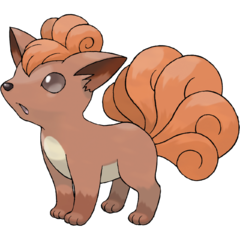
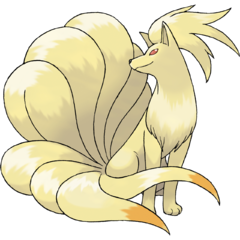
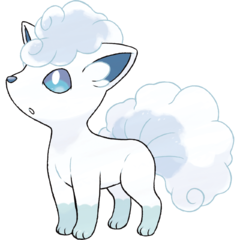
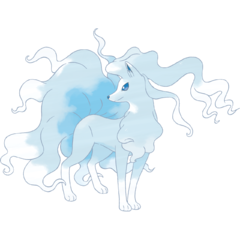
If you didn't pick Charmander, you're in luck, because there's Vulpix... if you're playing the Blue or Green version, that is, as they're only found on those versions (Red players get Growlithe instead). Vulpix resembles an adorable six-tailed red fox, while Ninetales is a large golden fox with... nine tails. Although they are pure Fire-types, they learn several Ghost and Psychic-type moves as well, owing to their mystical nature as kitsune.
Vulpix and Ninetales were originally brought to the Alola region by people, but since then they've moved to the snowy mountains where there was less competition. These Vulpix discarded their original Fire-type and became Ice-types in the process. Upon evolving to Alolan Ninetales, it will be an Ice/Fairy-type.
- Achilles' Heel: Being Ice/Fairy-types, Alolan Ninetales do not appreciate Steel-type attacks.
- Asian Fox Spirit: They're based on the kitsune. Vulpix has six tails while Ninetales, as the name suggests, has nine tails, the highest number that kitsune can possess.
- Balance Buff: Gen V gave them the Drought ability, allowing them to hit harder with Fire-type attacks while improving their chances against Water-types on their own with Solar Beam, as it can be charged immediately on the turn that it's used under the Drought ability's Sunny Day effect.
- Barrier Warrior: The Alolan Vulpix line are among the very few Pokémon to learn the move Aurora Veil, which creates a barrier that halves damage from both physical and special moves while active (effectively Reflect and Light Screen combined), but can only be used during hail. The catch here is that they were the first to also get Snow Warning while knowing Aurora Veil at the same time, which automatically summons hail when they enter battle and thus lets them use the move immediately (the Snow Warning-Aurora Veil combo also became available to Abomasnow and Vanilluxe in Generation VIII).
- Beware the Nice Ones: Alolan Ninetales are considerably kind and much nicer than their Fire-type cousins, but don't be too careless. They still possess dangerous powers and will unleash their vengeful streak if you decide to be a jerk.
- Breakout Character: Vulpix was very popular early on, and was featured in merchandise in Gen I; however, it slowly faded over time as other Pokémon came to the forefront. The Ice-typed Alolan Vulpix, on the other hand, has received a lot of promotion in Sun and Moon-related media as the premiere representation of Alolan forms. One even appears in the anime as Lillie's first Pokémon and they appear in Pokemon Legends Arceus - the only non-Hisuian Regional form to do so.
- Cunning Like a Fox: Vulpix are clever and skilled in deception, and Ninetales have psychic powers.
- Disc-One Nuke: Not to the level of Distaff Counterpart Growlithe in Shield, but Ninetales in Sword can follow the same trick. Catch a Vulpix or two in the right conditions in one of the first parts of the Wild Area, find the Fire Stone just after the bridge over the Motostoke River, and take your pair to the Daycare Center to breed. Use the Fire Stone on the hatched egg and take it to the Move Tutor in Motostoke's Center to have a Ninetales loaded down with a moveset like Flamethrower, Extrasensory, Confuse Ray, and Will-o-Wisp. While more limited, the powerful moves (Flamethrower has 90 power, Extrasensory has 80, and both run off a nice 81 Special Attack) are rare until you get to the second loop and Ninetales will still serve well until well into that, particularly with replaxing Extrasensory with Hex from Ballonlea (only 65 power, but doubles to 130 if inflicted with a status condition).
- Disproportionate Retribution: Touch one of Ninetales', well, tails, and prepare to be cursed for one thousand years. Alolan Ninetales are a bit more benevolent, but it still doesn't like it when you damage its territory. In keeping with their grudgeholding theme, Ninetales learns Nasty Plot, Spite, and Grudge by level up.
- Distaff Counterpart: To the Growlithe line. Though they can be either gender, the Vulpix line has a 75% chance of being female, while the Growlithe line has a 75% chance of being male.
- The Dragonslayer: Alolan Ninetales specifically. It is the first — and currently only — Ice/Fairy type in the history of the Pokémon franchise, which gives it a huge type advantage over Dragons. Both Ice and Fairy are super effective to the Dragon-type, and Fairy is outright immune to the Dragon-type, allowing Alolan Ninetales to decimate most Dragon-Types it facesnote . Steel-Types like Dialga, Duraludon/Archaludon, and Hisuian Goodra on the other hand....
- The Fair Folk: Ninetales are based on the mystical kitsune and has the less-than savory tendency to curse humans who touch them (which comes up as a plot-point in Pokémon Mystery Dungeon: Rescue Team), and even mind-control them. Their Fairy typing in their Alolan variant definitely fits them.
- Fire/Ice Duo: With the addition of the Ice-Typed Alolan forms, this duality was created for this family.
- Foil: To the Growlithe line, being two-stage Fire-type families based on mythological animals, evolving with the Fire Stone, and being version exclusive to the opposite games in both Kanto and Johto.
- Fragile Speedster: Even when their summoned weather is up, these foxes don't hit very hard, and their defenses are just barely average. Alolan Ninetales even takes a few points from Attack in order to be a bit faster - going from 100 to 109. Alolan Ninetales gets a bit better in Generation IX onwards where Snow increases its defense by 50%.
- Fusion Dance:
- According to an in-universe legend mentioned in a Pokédex entry, nine saints were united and reincarnated as Ninetales.
- Another Pokédex entry says that nine wizards possessing sacred powers merged into one. Whether this is a retcon, a mistranslation, or a separate legend is not clear.
- Gameplay and Story Integration: Befitting their general mysticism and mysteriousness, wild Vulpix are usually found close to ruins, shrines, or graveyards.
- Glass Cannon: In Gen 1, Ninetales was fast and hit pretty hard due to its high special. It was nerfed in Gen 2 with its high special being relegated into Special Defense, turning it into a Fragile Speedster.
- Glowing Eyes of Doom: When Ninetales controls people's minds, its eyes glow.
- Green Thumb: Kantonian Ninetales learns Solar Beam and was also the first Fire-type Pokémon to learn Energy Ball.
- Hypnotic Eyes: Ninetales can control minds with its red eyes.
- An Ice Person: Unlike most of the world's Vulpix and Ninetales, the ones that inhabit Alola are Ice-types.
- Icy Blue Eyes: While regular Ninetales have red eyes, Alolan Ninetales have piercing blue ones instead.
- Informed Ability: According to the Pokédex, Ninetales will curse anyone who touches its tails. It doesn't like those tails being touched in Pokémon-Amie, true, though the worst it'll do to you is make an annoyed face. Averted in Pokémon Mystery Dungeon: Rescue Team, where it's a major plot-point.
- Informed Attribute: According to the Pokédex, Vulpix is born with only one white tail that gains color and splits into six as it ages. Yet when you hatch a Vulpix from an egg in the games, it already has all six tails. The anime also portrayed Vulpix hatching with all six tails. However, in the manga Pocket Monsters Emerald Challenge!! Battle Frontier, the lead's Vulpix starts with one tail and grows the other five partway through.
- Intellectual Animal: The Pokédex states that Ninetales is highly intelligent and capable of understanding human speech.
- Light Is Good: Unlike Kantonian Ninetales, which fall under Light Is Not Good, Alolan Ninetales have been considered deities and are far more benevolent.
- Light Is Not Good: Ninetales has light-colored fur, but is an extremely vindictive Mon with the ability to control minds and inflict long-lasting curses.
- Long-Lived: Ninetales supposedly lives for 1,000 years, with the oldest of their species having fur that takes on a golden hue.
- Lunacy: The Alolan forms can learn Moonblast through breeding. Alolan Ninetales also receives STAB on the move due to being part-Fairy.
- Mama Bear: Alolan Ninetales will appear and freeze strangers who carelessly approach its Vulpix.
- Mana Burn: Ninetales is one of the few non Ghost-types that learns Spite by level-up, a Ghost-type move that removes 4 PP from the last move an opponent used.
- Mascot: Both varieties of Vulpix are mascots for real world Japan's Hokkaido Prefecture.
- Mind Manipulation: They can learn Confuse Ray to confuse their opponents.
- Multiple-Tailed Beast: Both Vulpix and the more appropriately named Ninetales.
- Nerf: Was a Lightning Bruiser on the Special Side in Generation I, but Gen II's Special split gave them lower Special Attack. Ninetales also suffered when weather setting abilities as a whole were changed in Gen VI to have weather caused by them last five turns instead of indefinitely.
- Nobody Touches the Hair: Alolan Ninetales doesn't enjoy having the hair on its head touched in Pokémon Refresh. On the other hand, it's perfectly fine with you touching its tails.
- One-Hit Kill: The Alolan Vulpix line can learn Sheer Cold, which has a chance of knocking out everything but Ice-type Pokémon in one hit.
- Our Angels Are Different: While the English website says that Alolan Ninetales are referred to as "sacred emissaries", the Japanese website outright says they were referred to as the "messengers of God" (神の使い, kami no tsukai). This is likely an allusion to Japanese mythology, where foxes are the messengers of the god Inari.
- Our Fairies Are Different: Alolan Ninetales are part-Fairy.
- Out of Focus: Whereas both forms of Vulpix have received fairly equal treatment since its Alolan form's introduction, Kantonian Ninetales tends to be ignored in favor of its Alolan form in spin-off games like Pokémon Unite (alongside Kantonian Vulpix) and Pokémon Café Remix (where both forms of Vulpix are present).
- Playing with Fire: Kantonian Vulpix and Ninetales are Fire-types - they were also some of the first Fire-type Pokémon to learn Will O' Wisp in Gen III, fitting with their mystical nature.
- The Power of the Sun: With Drought powering-up their Fire-type moves and letting them fire-off Solar Beam in a single turn.
- Psychic Powers: Learns Extrasensory by leveling up, and Ninetales can learn Psyshock, Calm Mind, and Dream Eater via TM.
- Red Eyes, Take Warning: You better take warning, lest you suffer a curse for a thousand years. According to Ninetales' Ruby Dex entry it can use its eyes to hypnotize people into doing its bidding.
- Ridiculously Cute Critter: Vulpix is praised for its beauty, and was the star Pokémon of a popular groomer in the anime. An Alolan Vulpix also joined the anime's cast where it became Lillie's first Pokémon.
- Scissors Cuts Rock: Alolan Vulpix can be bred to know Freeze-Dry, allowing it to deal super-effective damage to Water-Types.
- Signature Move: Aurora Veil is only learned by exactly a dozen species and Mew to begin with, and out of those dozen, Alolan Vulpix and Ninetales are the most likely to be using it.
- Sins of the Father: Ninetales' Ultra Sun Dex entry mentions that its 1,000 year curses can be passed down to the offender's descendants.
- Soul Power: They learn quite a lot of Ghost-type moves, attributed to their supernatural nature. They were also some of the first Fire-type mons to learn Will O' Wisp, a move mostly associated with Ghost-type Pokémon.
- Status Buff: Ninetales can jack up its normally average Sp. Attack with Nasty Plot via Move Relearner, and can learn Calm Mind to boost both Sp. Attack and Sp. Defense through TM. They were later given Howl and Agility.
- Squishy Wizard: Ninetales can fend off Special attacks, and Drought/Snow Warning patches up its below-average attacking prowess, but its physical defenses are lacking.
- Support Party Member: Alolan Ninetales, with a nice array of support moves like Encore, Icy Wind, Hypnosis, and Aurora Veil, can serve as an effective Doubles partner to a more offensive Pokémon. It can opt to fire off some perfect accuracy Blizzards too, which gives Alolan-Ninetales a bit more punch than the typical support Pokémon.
- Took a Level in Kindness: Alolan Ninetales to their cousins in other regions. They're described as being very gentle and are even known to help humans in distress at times, but maintain their vengeful streak for people who desecrate their homes. The Pokédex in Ultra Sun reveals this kindness might be more pragmatism than anything else, although this implication was cut in Alolan Ninetales's Shield and Legends Arceus's Pokédex entries.The reason it guides people all the way down to the mountain's base is that it wants them to hurry up and leave.
- Underground Monkey: Alolan Vulpix look like a Palette Swapped version of regular Vulpix with an Ice typing and less defined curls. Alolan Ninetales have long tresses of pale blue fur.
- Was Once a Man: Or rather, nine men, according to the Pokédex.
- Weak Sauce Weakness: Steel-type attacks will shatter the Alolan line into fine dust.
- Weather Manipulation: Their Hidden Ability, Drought, causes intense sunlight for 5 turns (permanent in the Generation 5 games). Their Alolan forms get Snow Warning to fit their new typing, summoning 5 turns of hail.
0174: Igglybuff / Pupurin (ププリン pupurin)
0039: Jigglypuff / Purin (プリン purin)
0040: Wigglytuff / Pukurin (プクリン pukurin)

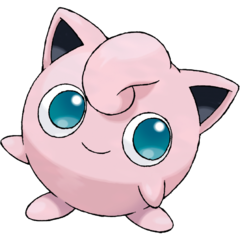

Another family of pink Pokémon. These Pokémon have balloon-like bodies, huge eyes, and a tuft of hair on their heads. Originally all pure Normal-Type, they have gained the Fairy-type in Generation VI. They have a high HP stat, and can learn a large number of moves, but their other stats are very average. Their talents include sleep-inducing singing.
Jigglypuff is one of the recurring playable characters in Super Smash Bros., Nintendo's Massive Multiplayer Crossover Fighting Game series. For tropes about its Smash incarnation, see the Super Smash Bros. 64 character page.
- Armored But Frail: Inverted. They have incredibly high HP, but poor defenses.
- Balance Buff: Wigglytuff got its Special Attack buffed in Generation VI, going from a below average 75 to a more acceptable 85. In addition, it was retconned as being part Fairy-type; combined with being given Competitive as an ability (which increases its Special Attack by two stages when a stat is lowered) and Fairy-type moves primarily classifying as Special, this makes Wigglytuff slightly more useful than before.
- Berserk Button: Be careful when trying to lower their stats. If they have the Competitive Ability, that will raise their Special Attack by two stages.
- Bizarre Alien Biology: The general inflatability of Jigglypuff. Igglybuff gets special mention because it generates a sweat with a calming scent.
- Breakout Character: Jigglypuff is popular enough in Japan to make multiple appearances in the anime, merchandise, and all games in the Super Smash Bros. franchise.
- Bunnies for Cuteness: Wigglytuff is a cute puffball with rabbit ears.
- Cuddle Bug: Wigglytuff fur is so soft and pleasant that if two of them cuddle, they won't want to separate.
- The Determinator: Once a Jigglypuff starts singing, it won't stop to breathe until its target is safely asleep. When it runs into an opponent that is difficult to knock out, this can lead to problems.
- Fingerless Hands: All three of them have stubby arms without visible fingers.
- Hyper-Destructive Bouncing Ball: Igglybuff is claimed to be this in its Pokédex entry. Supposedly, if something causes it to start bouncing nothing can stop it.
- Killer Rabbit: According to its Pokédex entry, Jigglypuff's cuteness is really a form of self-defense, luring enemies in only to put them to sleep and give them a beating. This is also a more literal example in the case of Wigglytuff.
- Living Gasbag: While these are filled with air and are even called the Balloon Pokémon, they don't really fly. In Pokémon GO, their balloon-like nature is alluded to by giving Jigglypuff a rather "floaty" jump and slow descent.
- Lunacy: Jigglypuff evolves into Wigglytuff with a Moon Stone.
- Magic Music: Jigglypuff's signature lullaby, which sends enemies to sleep. Just about every one of its traits or abilities is about singing — it inflates for the breath to perform longer and its eyes capture the enemy's attention to provide an opening.
- Master of None: Wigglytuff's massive HP is offset by its terrible defenses, and it also has poor offenses. After its Balance Buff in Gen VI and the addition of Competitive, at least it gets a small role as a Stealth Rock setter that discourages the use of Defog.
- Meaningful Name: Their English names combined perfectly represent the whole line, being wiggly, jiggly, and puffy living balloons with skin like comfy buff leather and a prominent tuft of hair. Their Japanese names also describe them well, being as soft and squishy as pudding (purin).
- Moon Rabbit: Wigglytuff gains rabbit ears upon evolving with the Moon Stone from Jigglypuff.
- Non-Elemental: Pure Normal-type until Gen VI, where they were reclassified as part Fairy-type.
- Our Fairies Are Different: As of Generation VI, the line is now also part Fairy-type. Before then, it was even in the Fairy egg group.
- Pink Is Feminine: Like the Clefairy line, they have a 75% chance of being female.
- Ridiculously Cute Critter: All of them. They seem to be designed to be cute.
- Signature Move: Sing is strongly associated with Jigglypuff.
- Super-Scream: Learns Hyper Voice and Disarming Voice naturally.
- Support Party Member: The line gets Helping Hand, Ally Switch, the Light Screen/Reflect pair, Heal Bell, Heal Pulse and Wish.
- Status Buff: Gen VI gave them the Competitive Ability, which boosts their Special Attack by two stages when any of their stats are dropped by the opponent. The line also gets the standard ones in Defense Curl, Work Up, Stockpile and the rare Minimize.
- You Have Researched Breathing: Despite most of Igglybuff's Pokédex entries talking about how easily it can bounce, it couldn't learn Bounce until Generation VIII. Even then, Igglybuff can only learn it by TM.
0041: Zubat (ズバット zubatto)
0042: Golbat (ゴルバット gorubatto)
0169: Crobat (クロバット kurobatto)


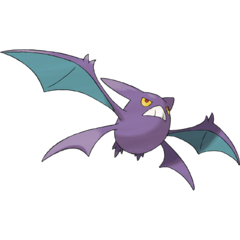
These bats are found in almost every cave for almost four generations of games. What makes them so annoying is their speed (where your chances of running away is determined by speed stats) and their ability to confuse or poison you if you choose to fight back instead of trying to run. Because they are so common and annoying, trainers often don't want to do anything with them. But if they're patient enough to catch and befriend one, they'll have a strong ally on their side. It has one of the highest Speed stats in the game. All three are Poison/Flying type, and as of Gen IX the only of its type combination, as well as the oldest since their introduction in Gen I.
- Always Accurate Attack: Learns Swift, a Normal-type attack that never misses, by leveling up.
- Armor-Piercing Attack: With their hidden ability Infiltrator, they can ignore moves like Reflect, and bypass Substitutes.
- Bat Out of Hell: Golbat and Crobat are person-sized vampire bats, Zubat is quite larger than most real bats, they are able to poison you, and generally annoying. The line is also a staple in villainous teams.
- Big Eater: Every one of Golbat's Pokédex entries mentions a voracious thirst for blood. By the end of a meal, Golbat can barely get itself off the ground.
- Blind Bats: Zubat, reflecting its cave-dwelling habits, has a completely eyeless face.
- Bloodsucking Bats: Golbat loves drinking blood. Sometimes it drinks so much blood that it becomes too heavy to fly and gets eaten by another Pokémon.
- Blow You Away: Flying-type bat Pokémon with moves like Whirlwind, Air Cutter, Brave Bird, Tailwind and Roost.
- Boss Battle:
- Crobat is Koga's signature Pokémon during his time in the Elite Four.
- The entire family line is popular with villainous teams, with grunts usually using Zubat and Golbat, and leaders usually using Crobat, which includes Archie, Maxie, and Cyrus.
- Combos: It gets Defog and Hypnosis by breeding (Defog is also an HM in Diamond, Pearl and Platinum). Defog's evasion-lowering effect makes Hypnosis more accurate. In Generation 6, Defog has the bonus effect of clearing all entry hazards on both sides of the field.
- Com Mons: Every cave in Kanto, Johto, Hoenn, Sinnoh, and Alola is filled with Zubat and/or Golbat. Despite that, Crobat is actually a pretty good Pokémon, with stats on par with the evolved starters.
- Crippling Overspecialization: In-universe, Crobat's four wings (two of which used to be its legs) make it very good at flying, but also very bad at walking and stopping to rest. Lampshaded in the Sun Pokédex, which states that it can only crawl around clumsily on the ground.
- Death or Glory Attack: Zubat can be bred to learn Brave Bird, despite the fact that it's not a bird.
- Disc-One Nuke: Crobat is roughly as strong as the evolved starters, and due to how happiness works, can be obtained one level after evolving into the already respectable Golbat with just a little tender loving care. In Platinum, wild Golbat are capturable (but rare) just after the first Gym, and theoretically one could get a Crobat at level 11. Platinum also has the TM for Return given to the player at the beginning of the game for even more power.
- Early-Installment Weirdness: One of the more notable examples of Kanto Pokémon not being allowed to evolve in remakes; Crobat cannot be obtained in FireRed and LeafGreen until after the National Pokédex is earned (which comes after the Elite Four and a lengthy post-game sidequest) and is not available at all in Pokémon Let's Go, Pikachu! and Pokémon Let's Go, Eevee!. While other Pokémon do have this restriction (Chansey, Scyther, Seadra, Electabuzz, Magmar, etc.), the Zubat line being Com Mons makes them the most prominent examples of this restriction.
- Eyeless Face: Zubat, but this makes some sense, as it is a blind bat that depends on echolocation. Hilariously, this means Alpha Zubat in Legends Arceus can't be recognized as such by their usual feature.
- Face of a Thug: Crobat always has a scowl on its face, but it only evolves into one when it's close to its Trainer. It may be ecstatic, erupting hearts and sparkles in Amie/Refresh, but its expression won't change.
- Flight: Naturally as Flying-types. Oddly, Zubat and Golbat could not learn the HM for Fly until Diamond and Pearl.
- Giant Flyer: Crobat is nearly six feet tall (or has a wingspan of nearly six feet, it's not clear which). Even with the dubious height calculations of the Pokédex, that's big.
- Irony:
- Crobat evolves via happiness, yet it's a Perpetual Frowner.
- Zubat is one of the purest examples of Com Mons in the series, yet, as of the Indigo Disk DLC in Scarlet and Violet, it (along with its first evolution, Golbat) is the only Pokemon of the original 151 that still has a unique type combination.
- Jack of All Stats: Pretty well-balanced stats, though their Speed stat is really high. Before Sun and Moon introduced Nihilego, Crobat was one of two Pokémon with the highest base stat totals of its type (Poison in Crobat's case) that isn't a Legendary or Mega Evolved (Tyranitar is the other, for Rock).
- Kryptonite Factor: According to the dex entries, the reason Zubat swarm inside caves so much is because their skin is super-sensitive to sunlight, and they have a tendency to burn easily. Not that this is ever a problem for any Zubat you see in the wild.
- Life Drain: Learns Absorb and Leech Life through levelling up, and Giga Drain by TM.
- Magically Inept Fighter: Unlike most Poison-types, the line overall has very poor Special Attack. However, they can learn Nasty Plot (either though breeding or TR) to make up for it.
- Magikarp Power: Annoying as it is, Zubat is much, much weaker than its evolved forms and with a horrible moveset to boot. Golbat will start to pull off more of its weight in battle, but it will take it until it becomes Crobat to become far more threatening.
- Master of None: Before Crobat came to the rescue, Golbat was this. While 90 Speed was good and 80 Attack not too shabby, its moveset was outright horrible.
- Mundane Utility: Crobat is excellent for catching Pokémon, as it learns moves like Super Fang (which can help weaken but not knock out opposing Pokémon), Mean Look (to prevent roaming Pokémon from fleeing), and Hypnosis (which can make Pokémon easier to catch by putting 'em to sleep).
- Obvious Rule Patch: Zubat's default attack was changed from Leech Life to Absorb in Generation VII after Leech Life got a major power increase.
- Overly-Long Tongue: Golbat in its Red and Blue
 ◊ sprite.
◊ sprite. - Perpetual Frowner: Crobat never cracks a smile. Even in Pokémon-Amie, when it's ecstatic or playing the Making Faces game. Even though it evolves through happiness.
- Pet the Dog: Several villains have Crobat on their teams to show that they have a softer side, as Golbat only evolves through happiness.
- Poisonous Person: Poison-types that are possibly based off the vampire bat (the only venomous bat).
- The Power of Friendship: It's the only way to evolve Golbat into Crobat. Many villain teams are given them to show they have a softer side.
- Punny Name: Crobat is one "a" removed from "Acrobat," and happens to be one of the fastest Pokémon in the game. And yes, it can learn Acrobatics.
- Razor Wind: Learns Air Cutter and Air Slash by leveling up.
- Shown Their Work:
- Golbat's Sword Dex entry for the Crown Tundra DLC states that it is said that if another Golbat is starving, they'll share their gathered blood with it, which is a trait shared by actual vampire bats.
- Golbat's Shield Dex entry mentions that it sneaks up on its prey by walking over it. Vampire bats are actually very robust walkers on the ground for this exact reason, albeit they walk quadrupedally as opposed to Golbat being bipedal.
- Status Buff: They can learn Nasty Plot, Curse and Agility as of Gen VIII.
- Status-Buff Dispel: They naturally learn Haze.
- The Stoic: Crobat, at least in Pokémon-Amie. Its facial expressions don't change at all. Its mouth doesn't even move when it eats.
- The Tooth Hurts: According to Golbat's Ultra Sun Pokédex entry, some Golbat have broken teeth from getting so hungry that they try to bite Steel-type Pokémon.
- Tooth Strip: Subverted. What looks like one of these on Crobat is actually an underbite formed by three large teeth.
- Useless Useful Spell:
- Can be bred to know Curse, which is a Speed-lowering move on one of the fastest Pokémon in the game.
- Their original ability, Inner Focus, prevents flinching. Crobat is usually fast enough to not have to worry about flinching in the first place, outside of Fake Out.
- Vertebrate with Extra Limbs: Subverted with Crobat; it appears to be this, due to the extra wings and what at first glance appear to be stubby feet on its backside. However, Pokédex entries confirm that Crobat's "extra" wings are actually modified legs.
- Vibration Manipulation: All of them learn Supersonic, and Golbat and Crobat can be taken to the Move Relearner to learn Screech, which are both sound-based moves.
- You Have Researched Breathing: Prior to Gen IV, Zubat and Golbat couldn't learn Fly.
0043: Oddish / Nazonokusa (ナゾノクサ nazonokusa)
0044: Gloom / Kusaihana (クサイハナ kusaihana)
0045: Vileplume / Ruffresia (ラフレシア rafureshia)
0182: Bellossom / Kireihana (キレイハナ kireihana)
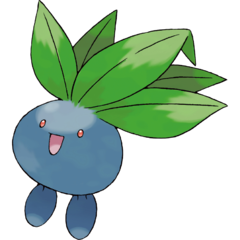
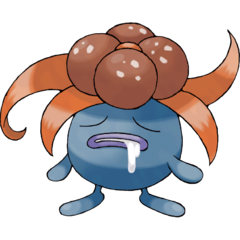
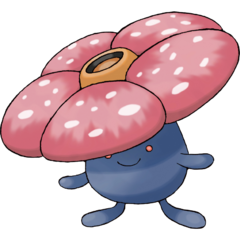
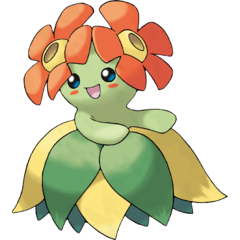
One of the archetypal Grass-type families, Oddish and its evolved forms are a good choice if you didn't start with Bulbasaur. Oddish resembles a radish that's blue in color and it walks on two feet. As it matures into a Gloom, it gains arms and becomes very smelly, much like a rafflesia. Finally can evolve into either a Vileplume, or a Bellossom... if you have one of the appropriate stones, that is. Bellossom is somewhat unique in that it shrinks in size and loses its Poison typing upon evolution, as well as losing its legs, which are replaced by a leaf-dress of sorts. In their debut generation, they were exclusive to the Red version.
- Armless Biped: Oddish, but it grows a pair of arms after evolving into Gloom.
- Attack! Attack! Attack!: Petal Dance forces them to attack for 2-3 turns before becoming confused.
- Balance Buff: In Gen VI;
- Vileplume got 10 extra points on its Special Attack, bringing it up to an impressive 110.
- Bellossom's 10 points went to Defense, now a much better 95, aiding its setup capabilities and making it better at being a Mighty Glacier.
- Beautiful All Along: Gloom, the middle evolution, is pretty much the least aesthetically pleasing. Evolving it into Bellossom is nothing short of an ugly duckling story. Even Vileplume seems like more of a reversion to Oddish's cuteness.
- Binomium ridiculus: Oddish's FireRed Pokédex entry states that its scientific name is "Oddium Wanderus". "Wanderus" refers to its habit of walking around at night.
- Blush Sticker: Bellossom.
- Boss Battle: The line is very heavily favored by Erika of Kanto alongside Bellsprout's - Vileplume is her strongest Mon in most games alongside Victreebel, i.e. is the fourth gym boss of Kanto, while Bellossom takes its place in the Johto games (at least in her gym battle). In Yellow, it's Gloom that's actually her strongest team member alongside Weepinbell, to tie in with its appearance in her episode of the anime.
- Com Mons: In Hoenn, where they are much more common than in Kanto or Johto.
- Cute, but Cacophonic: In its Yellow and Let's Go dex entries, Oddish is stated to "shriek horribly" when it's pulled out of the ground, just like the mythical variant of the mandrake.
- Dance Battler: Bellossom, especially if it has Petal Dance.
- Discard and Draw: Except without the "draw" part. The evolution of Gloom to Bellossom is the only time a Pokémon permanently loses one of their types without it getting replaced.
- Dude Looks Like a Lady: Half of all Bellossom are male, even though they still wear flowers and hula skirts.
- Exactly What It Says on the Tin: Gloom's Japanese name is Kusaihana, which literally translates to "smelly flower". Bellossom's Japanese name is Kireihana, which literally translates to "beautiful flower". Vileplume's Japanese name is Rafflesia, and it is, indeed, a Rafflesia
 .
. - Foil:
- To the Victreebel line, at least in the Kanto games, with both being three-stage Grass/Poison families with identical evolution requirements (Lv. 21 -> Leaf Stone) who are exclusive to the opposite versions. They have the same stat total, with Vileplume being more well-rounded while Victreebel is a mixed Glass Cannon with slightly higher speed. Bellossom's introduction in Gen 2 offsets the parallel by a bit, possibly explaining why the families don't remain version-exclusive in future appearances beyond remakes of the Kanto games where Bellossom isn't accessible until at least the post-game.
- Bellossom is in and of itself one to Vileplume as an alternate evolution for Gloom, with Vileplume retaining its Poison-type and shady appearance while Bellossom is "cured" and becomes a healthier-looking pure Grass-type. Their stat distributions are also very similar, with Vileplume's Special Attack and Bellossom's Special Defense stats simply being reversed throughout Gens 2-5, while Gen 6 gave both evolutions separate +10 base stat buffs to Special Attack and (physical) Defense, making Vileplume even more of a special attacker while Bellossom became the all-around defensive evolution.
- Gameplay and Story Segregation: Despite Gloom's stench being its most often mentioned trait, it didn't actually get the Ability Stench at first, only Chlorophyll. It didn't get Stench until Gen V, and only as a Hidden Ability.
- Garden Garment: Bellossom's lower half resembles a skirt made of leaves.
- Girly Skirt Twirl: One of Bellossom's idle animations in Gen VI is a happy twirl.
- Glacier Waif: Bellossom looks too frail and tiny to come off as tough compared to Vileplume, but it has an impressive Sp. Def stat of 100.
- Green Thumb: They're all part Grass-type, with Bellossom being pure Grass.
- Irony: Despite Bellossom looking like a Hawaiian hula dancer, and the fact it's depicted in certain locations in Alola (based on Hawaii), the Oddish line can't be found in the wild in that region.
- Killer Rabbit: Despite its cute appearance, Vileplume is a carnivore that uses its beautiful petals to lure in prey and douses them with toxic spores before devouring them.
- Lunacy: Being Nocturnal Mooks (see below), Oddish and Gloom are able to learn Moonlight and, in the case of the former, Moonblast. According to some Dex entries, Oddish even needs moonlight to grow.
- Meaningful Name: A Rafflesia (Vileplume's name in the Japanese version) is the largest flower in the world and produces a highly foul odor, and the flower on its head highly resembles one. This may also go to explain why Gloom smells so bad.In-Depth Explanation
- Mighty Glacier: Both Vileplume and Bellossom have decent physical stats and good special stats, with their Speed stat being their sole downfall at a paltry 50.
- Missing Secret: In Gold and Silver, the line has the move Charm listed as a possible Egg Move, but it's impossible to learn legitimately since no eligible breeding partners have it. This was fixed in the Generation III games, where it can learn it from the Shroomish family.
- Mythical Motifs: Oddish borrows some features from the mandrake, including its status as a walking root and its tendency to scream when pulled out of the ground.
- Nocturnal Mooks: Oddish and Gloom can only be encountered at night in Johto. In-universe, Oddish hide in the ground during the day and only come out when the sun falls.
- Perpetual Frowner: Gloom, unsurprisingly.
- Perpetual Smiler: Oddish, Vileplume, and Bellossom.
- Petal Power: Learns Petal Dance, and their folliage is easily their most defining feature.
- Pintsized Powerhouse: As noted above, Bellossom is the smallest form of the family, yet its stats are on par with the alternative evolution Vileplume.
- Plant Person: Oddish is a mandrake crossed with a radish, Gloom is a weedy plant. Vileplume is a rafflesia and Bellossom is a flower Pokémon.
- Poisonous Person: All of them but Bellossom are part Poison-type.
- Red Eyes, Take Warning: Oddish and Vileplume have eerie red eyes belying their creepy nature.
- Ridiculously Cute Critter: Oddish, who many of the early creators have said they have a soft spot for. Bellossom is also incredibly adorable.
- Secondary Sexual Characteristics: Female Vileplume have larger white spots on their flowers.
- Secret Art: Petal Dance, but only in Generation I.
- Stone Wall: Bellossom leans on this due to the increase to its Defense stat, thus sandwiching it between both its Special stats.
- Waddling Head: Oddish, whose face is on its body and lacks arms too.
0046: Paras (パラス parasu)
0047: Parasect (パラセクト parasekuto)
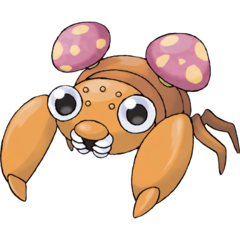

Paras and Parasect are an interesting![]() family. It's a cicada-like insect that's in a symbiotic [read:parasitic] relationship with a mushroom that only grows on the bug. Thus, it has both Bug and Grass types. This comes with a cost, though: Upon evolution, the mushroom takes over the insect's brain and it seems that it's the mushroom that is in control of the creature. It's considered a great Pokémon to catch other Pokémon with, though, since it has access to Spore, one of the best sleep-inducing moves in the game, and False Swipe, which will never reduce a target's health below one. Just keep it away from heat or hungry birds.
family. It's a cicada-like insect that's in a symbiotic [read:parasitic] relationship with a mushroom that only grows on the bug. Thus, it has both Bug and Grass types. This comes with a cost, though: Upon evolution, the mushroom takes over the insect's brain and it seems that it's the mushroom that is in control of the creature. It's considered a great Pokémon to catch other Pokémon with, though, since it has access to Spore, one of the best sleep-inducing moves in the game, and False Swipe, which will never reduce a target's health below one. Just keep it away from heat or hungry birds.
- Attack! Attack! Attack!: The Paras found in Hisui are ludicrously over-aggressive for their size, and will attack any human on sight.
- Big Creepy-Crawlies: A foot and three feet tall, respectively.
- Blank White Eyes: Parasect, as a result of losing its mind to the mushroom... or perhaps due to this being a common effect of the fungus it's based on
 .
. - Body Horror: Upon evolving, the mushrooms on Paras's back completely take over Parasect and turn it into a warped zombie of its former self. Yeesh.
- Cherry Tapping: In Gen VI, it can be bred to know the move Fell Stinger. This move has a paltry 30 Power, but if you knock an opponent out with it, you get a 250% boost to your attack. Alternatively, you could just use Swords Dance.
- Crippling Overspecialization: The reason Parasect has such awful stats, particularly being tied with Snorlax and Slowbro for the slowest fully-evolved Pokémon in Gen 1, is because it and its pre-evolution Paras were the only Pokémon who could learn Spore, a 100% sleep-inducing move while no other sleep move had better than 75% accuracy. With sleep being such a game-breaking status in Gen 1, Parasect needed to be bad stat-wise and be so slow, as otherwise it would have been an incredibly powerful and frustrating Pokémon. With the sleep status being made less powerful in future gens and other, more powerful Grass types being given Spore like Breloom, this aspect of Parasect has been lost, making it one of the franchise's weakest choices.
- Elemental Absorption: With Dry Skin, Water-type moves will heal them.
- Empty Shell: The mushroom's in control of Parasect's body. Without it, the remains just stay where they are. Pokédex entries mention finding Parasect husks are not an uncommon sight.
- Glass Cannon: Despite being able to learn Swords Dance in most generations and having good Attack, Parasect's defenses are just mediocre. It also six weaknesses, with two (three in the first generation) doing quadruple damage. Also, if it has the Dry Skin ability, it takes quintuple damage instead from Fire-type moves.
- Green Thumb: Both of them are part Grass-type.
- Healing Factor: If they have Dry Skin and it's raining in battle, their HP will be restored by 1/8 of their maximum every turn.
- Kryptonite Is Everywhere:
- Notable in that it has the second-worst defensive typing in the game, tied only with Bug/Ice; not only does it receive a double weakness to Fire (it can take 5x damage from Fire with Dry Skin as its ability) and Flying, two common offensive types, but also single weaknesses to Ice, Poison, Rock, and ironically Bug, which are also common in some form.
- Thanks to Poison dealing super-effective damage on Bug-types in the first generation, Paras and Parasect are the only Pokémon to have ever had three double weaknesses.
- Our Zombies Are Different: Parasect is a mindless husk of a bug that has been completely taken over by its mushroom.
- Puppeteer Parasite: The mushrooms on Paras's back are influencing its thoughts, and draining nutrients from Paras to feed itself. Oddly, though, in the anime it's shown Paras can take its mushrooms off whenever it wants.
- Secret Art:
- Spore, exclusive to them and the other three mushroom-based families — in fact, the move's Japanese name is Mushroom Spore.
- There's Effect Spore
 , which is a unique ability. Only the Paras line and the other three mushroom-based families get it naturally, though Vileplume has it as its Hidden Ability.
, which is a unique ability. Only the Paras line and the other three mushroom-based families get it naturally, though Vileplume has it as its Hidden Ability.
- Status Buff: Through breeding in Gen VI, Parasect is one of two Grass-Types (the other is Cacturne) that can learn Rototiller, which can boost its Attack and Special Attack by one stage like Work Up, which it can't learn, without having to be in a Double or Triple Battle. In such battles, any Grass-Type allies or enemies can reap the bonus as well.
- Status Effects: Can learn Spore, a sleep-inducing move that has perfect accuracy. Its Effect Spore ability has a random chance of inflicting Sleep, Paralysis, or Poison if the opponent uses a contact move on it.
- This Looks Like a Job for Aquaman: With its underwhelming stats and myriad of weaknesses, Parasect has virtually no viability in the Metagame, especially not when there are more capable users of Spore such as Breloom or Amoongus. However, since Parasect also gets False Swipe, an attack which prevents it from knocking out the opponent, which when combined with having a fully accurate sleep move, makes it a useful Pokémon for capturing wild Pokémon (at least ones that aren't Fire or Flying-type).
- Too Long; Didn't Dub: Pokedex entries refer to the mushrooms on Paras and Parasect as Ophiocordyceps sinensis
 . The English versions consistently leave the Japanese name tochukaso untranslated, perhaps because the common name "caterpillar fungus" references a real animal.
. The English versions consistently leave the Japanese name tochukaso untranslated, perhaps because the common name "caterpillar fungus" references a real animal. - Weaksauce Weakness: To both Fire-, and Flying-type moves. Even a weak Ember may put them out of commission.
- Weak to Fire: It can have a 5x weakness against Fire moves if it has Dry Skin, giving the line the dubious honor of being the only Pokémon that can take more than 4x damage from an attack under normal conditions.




